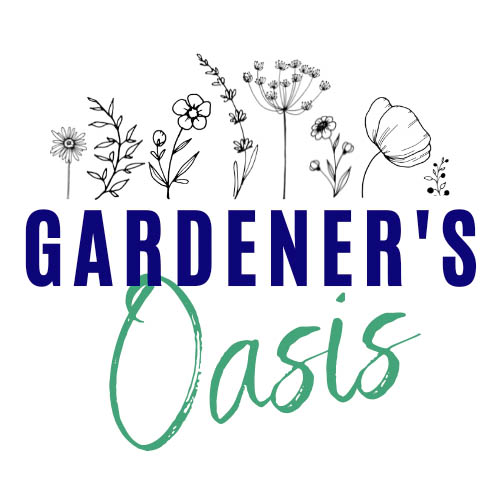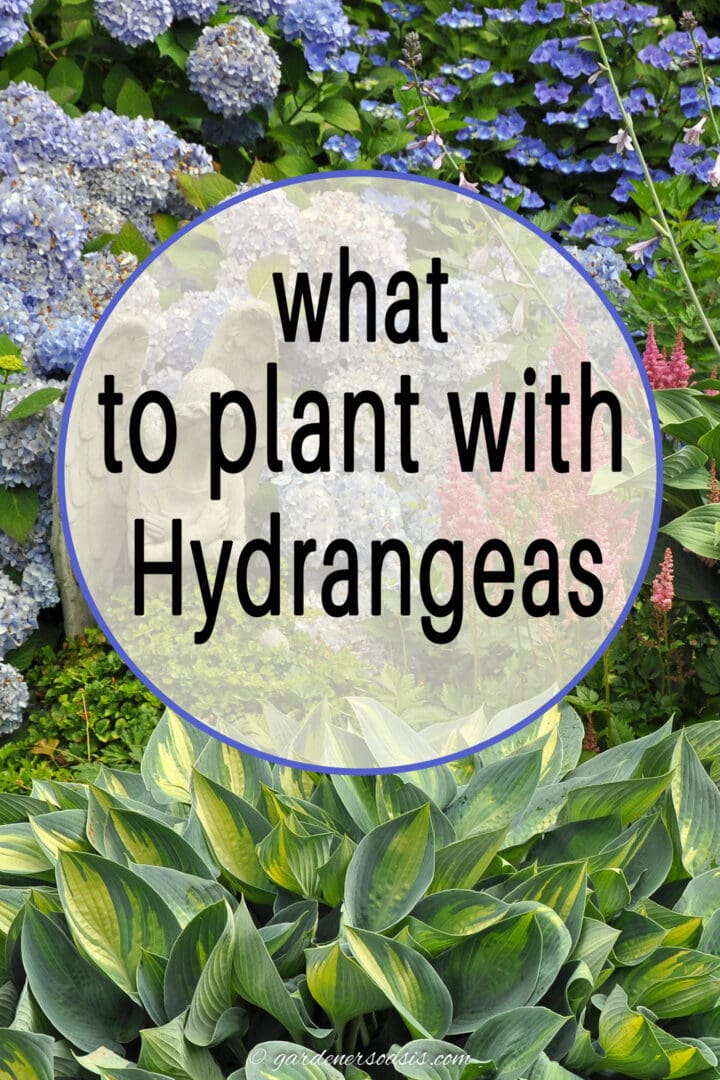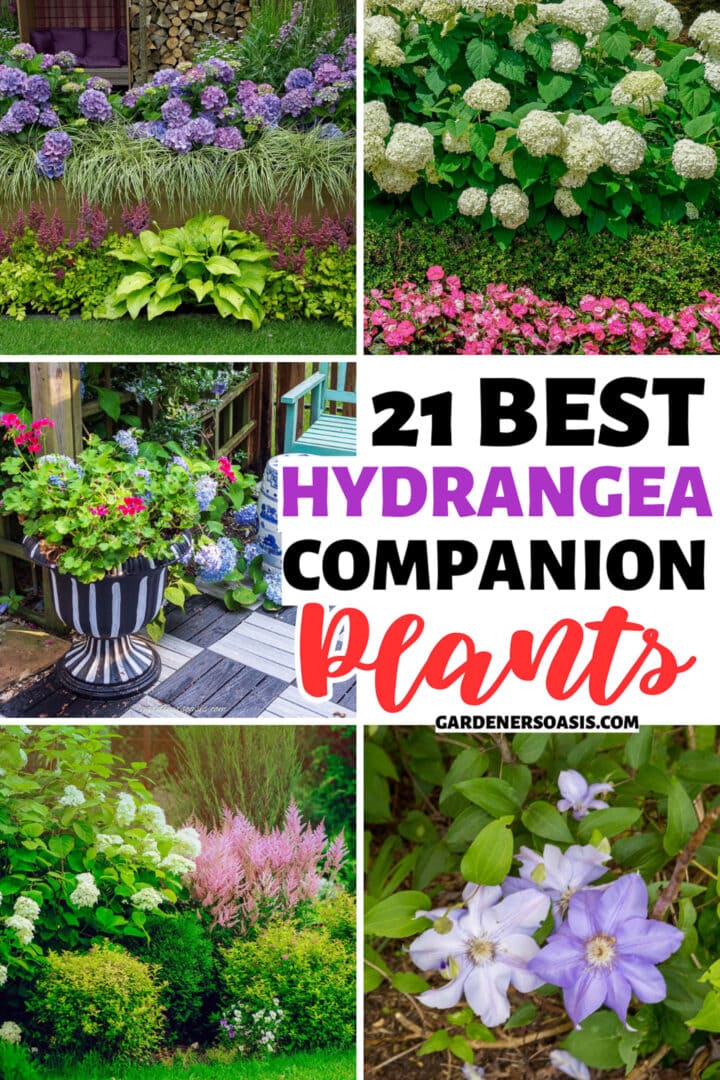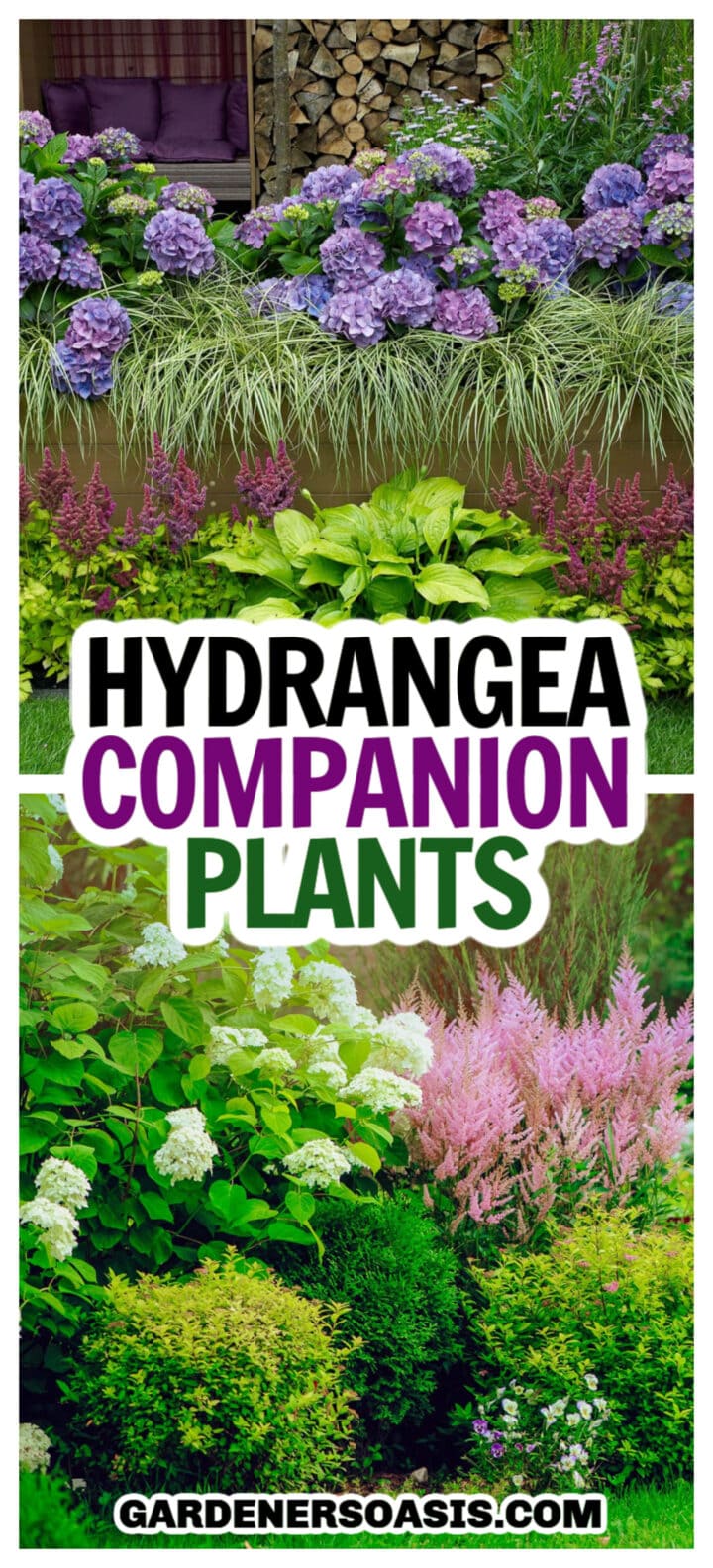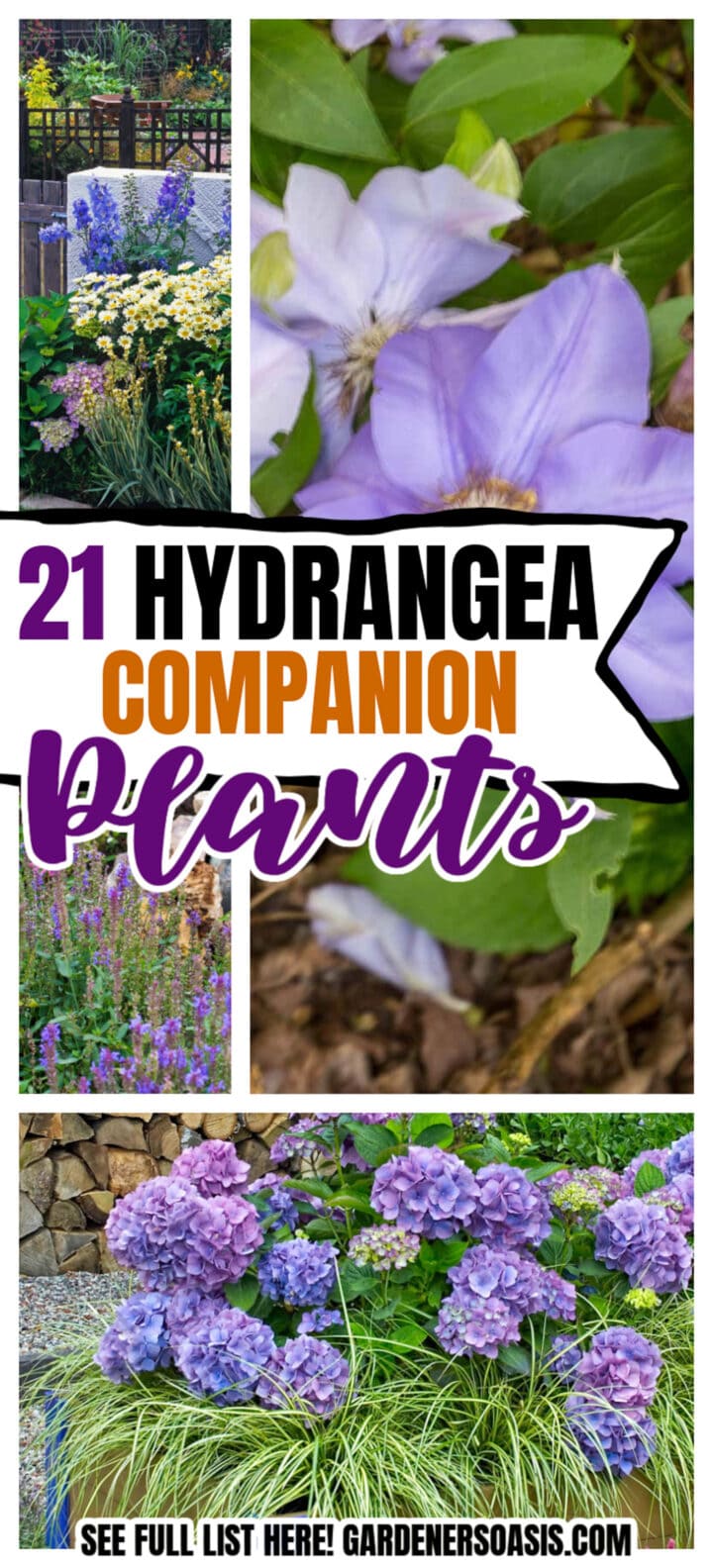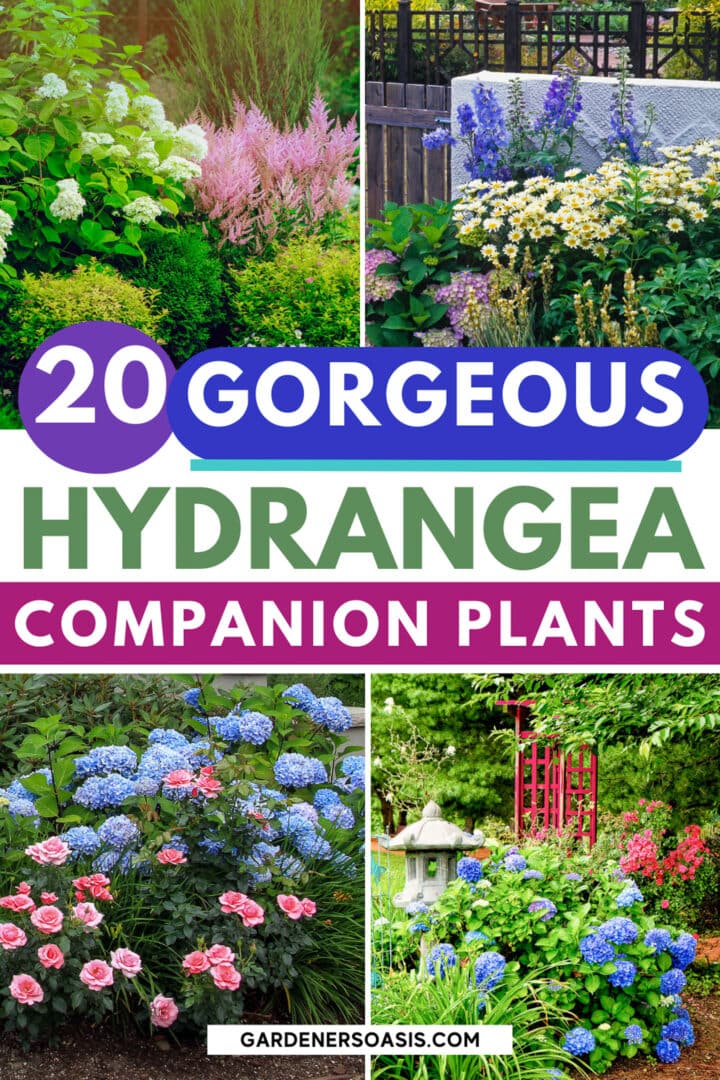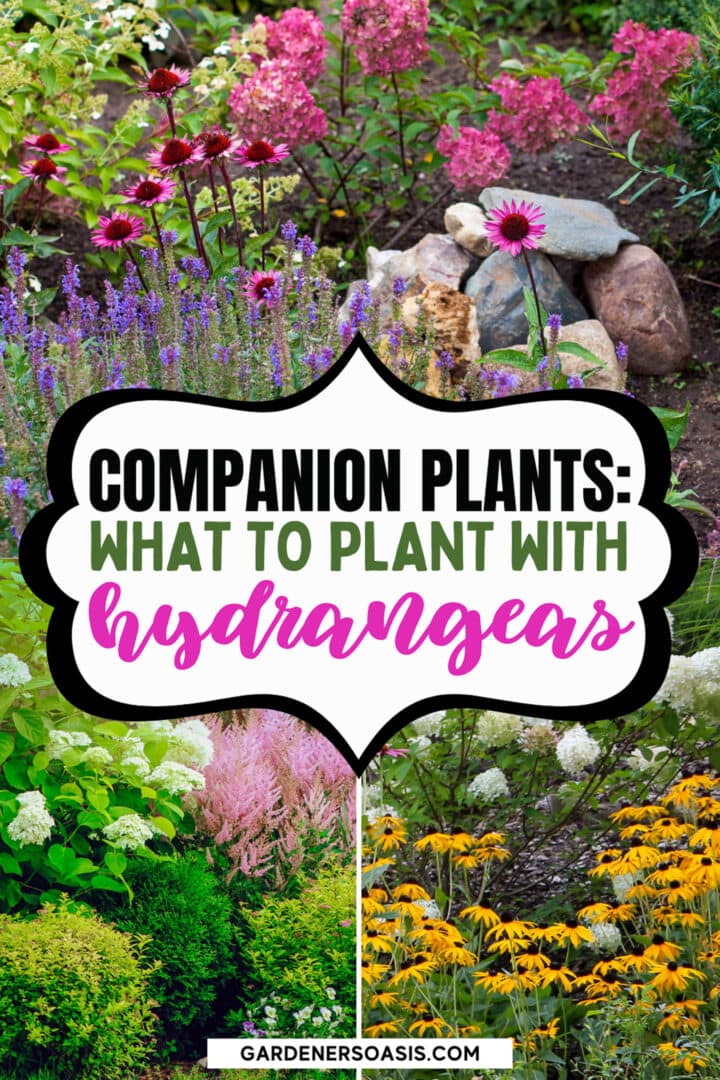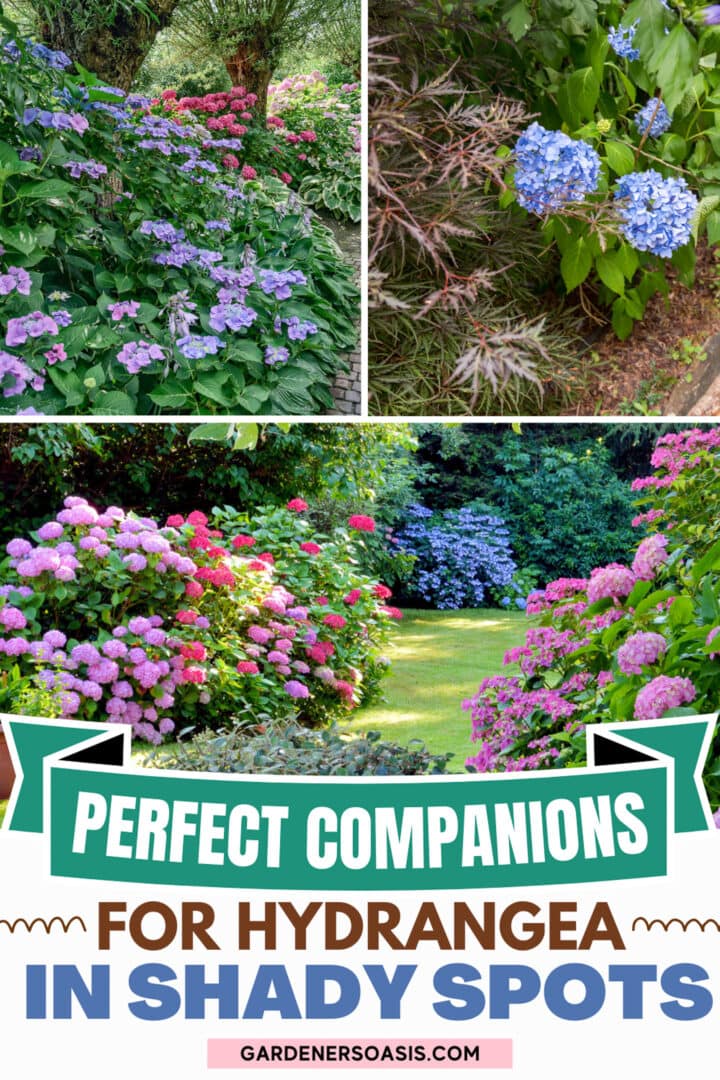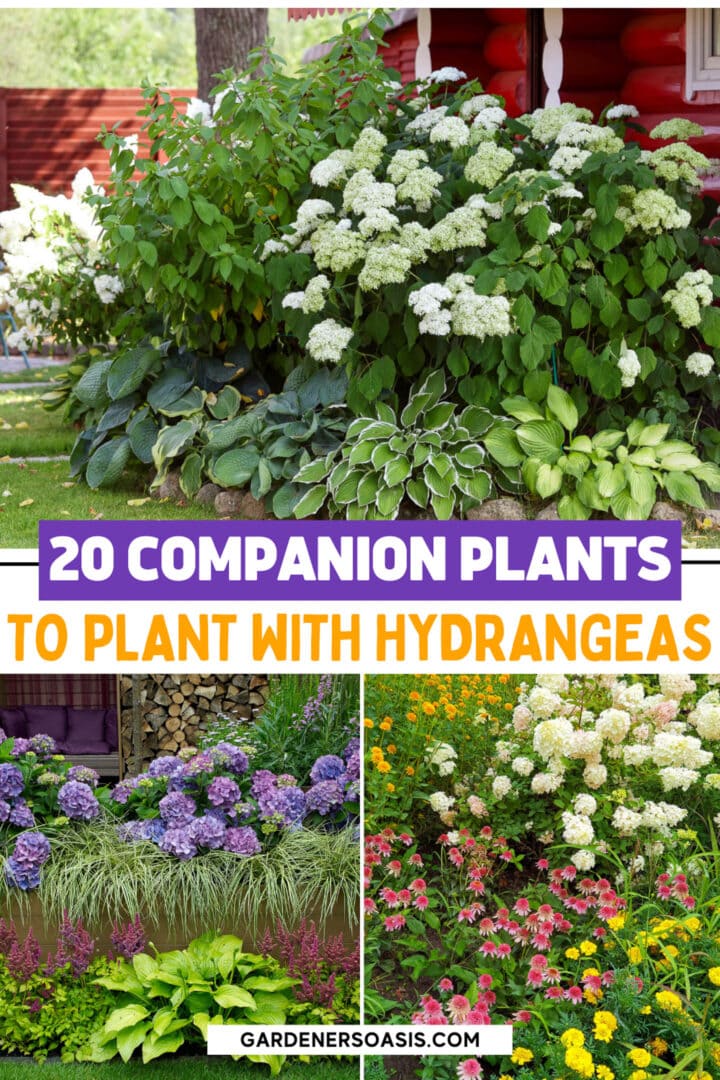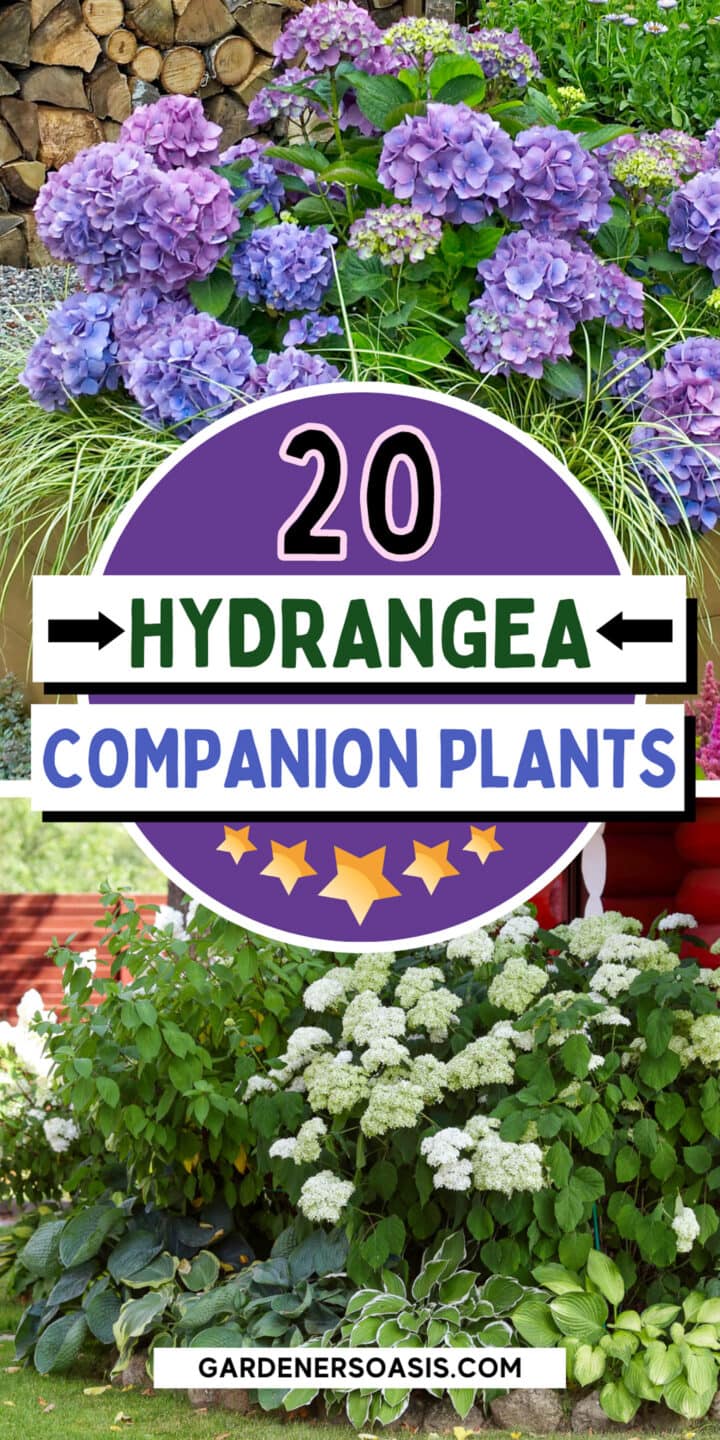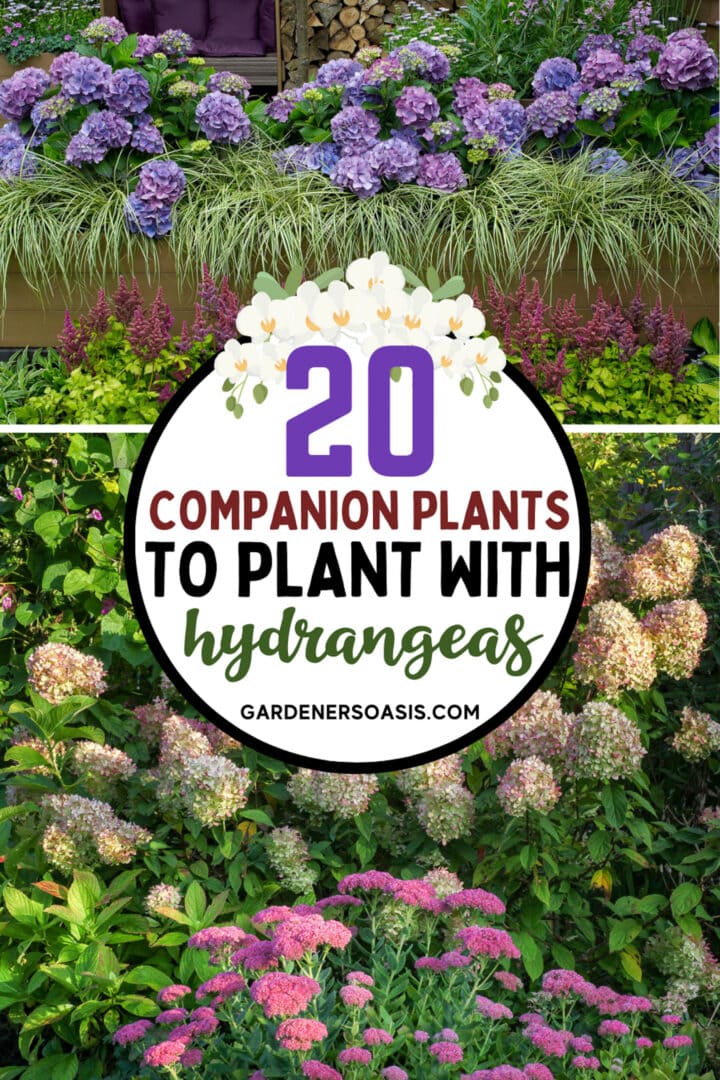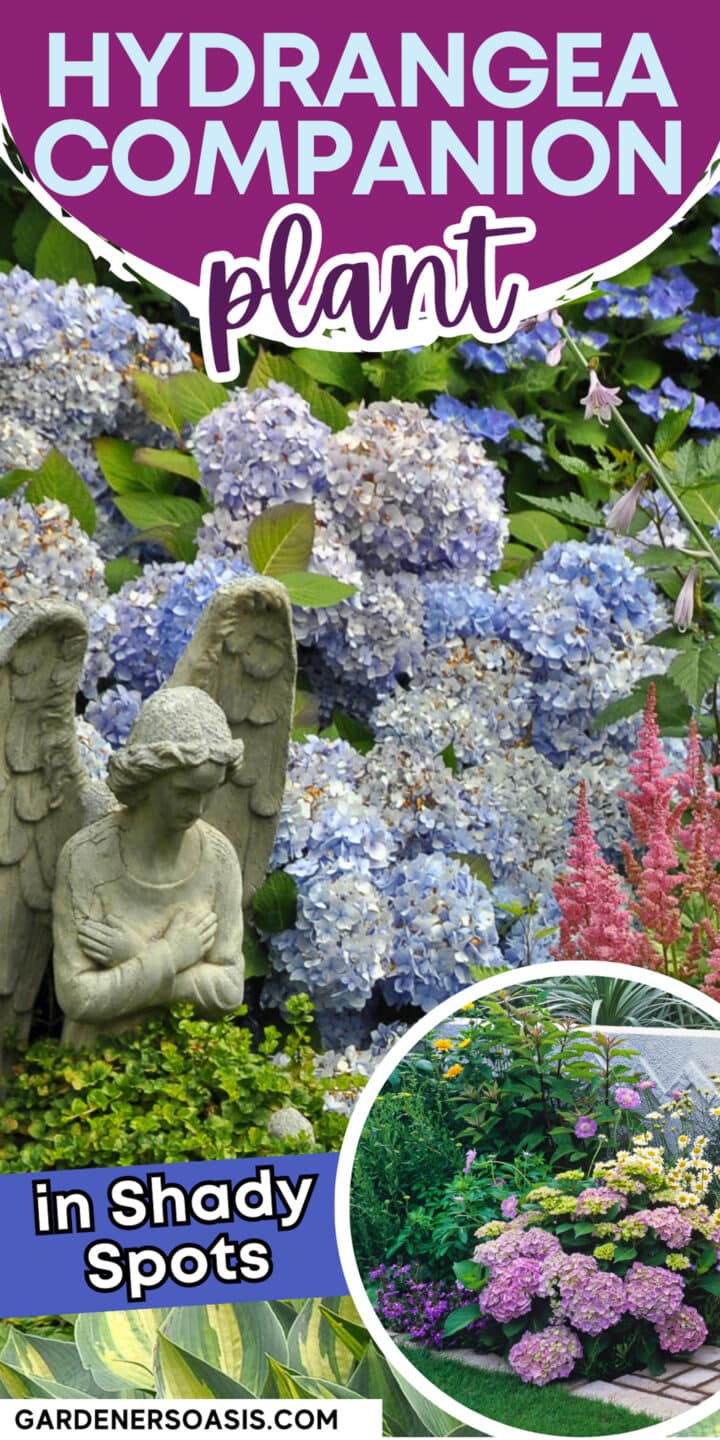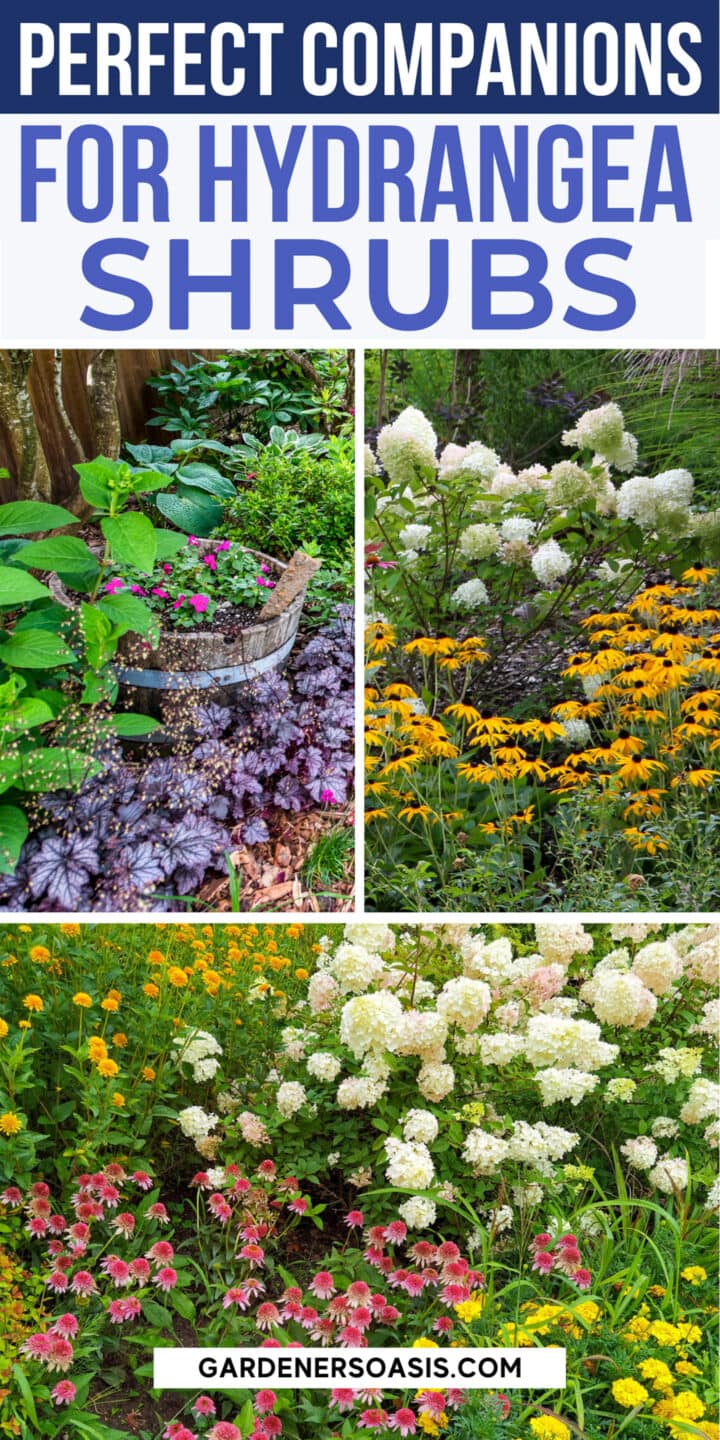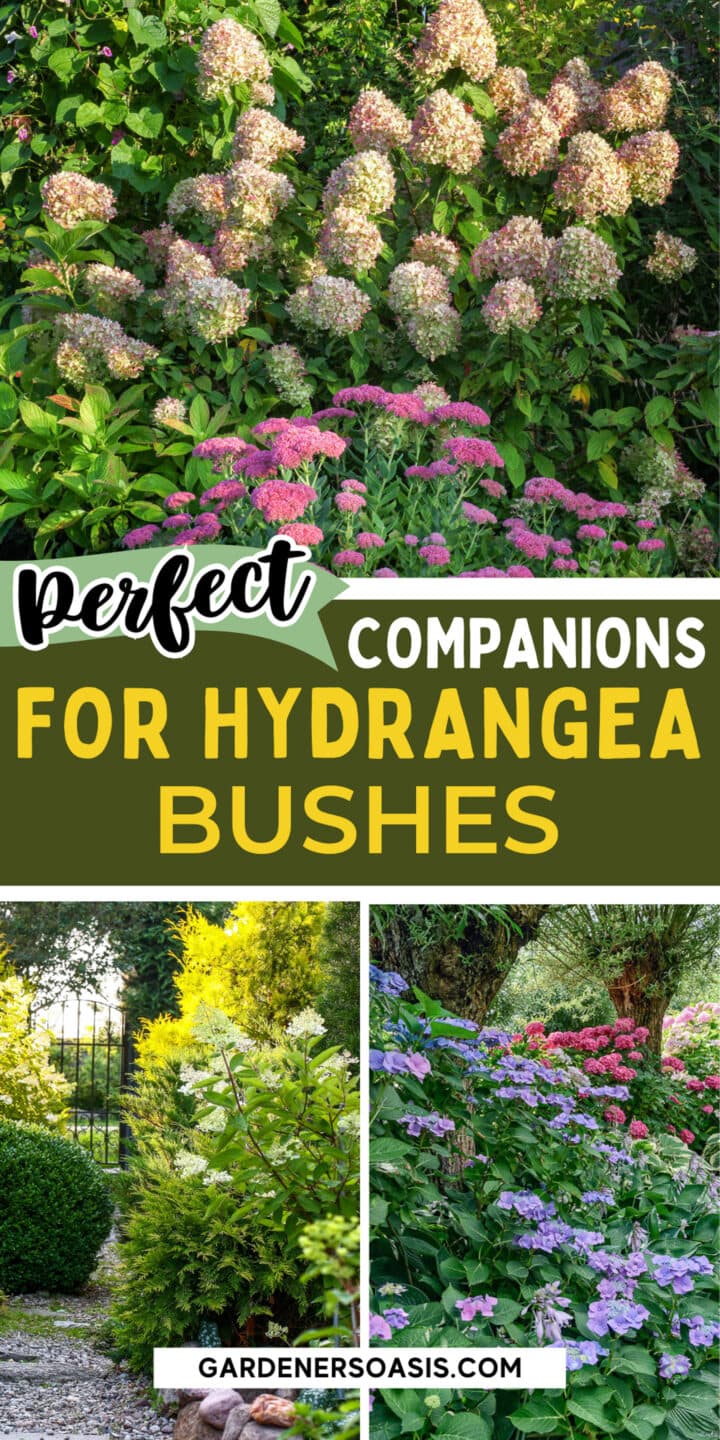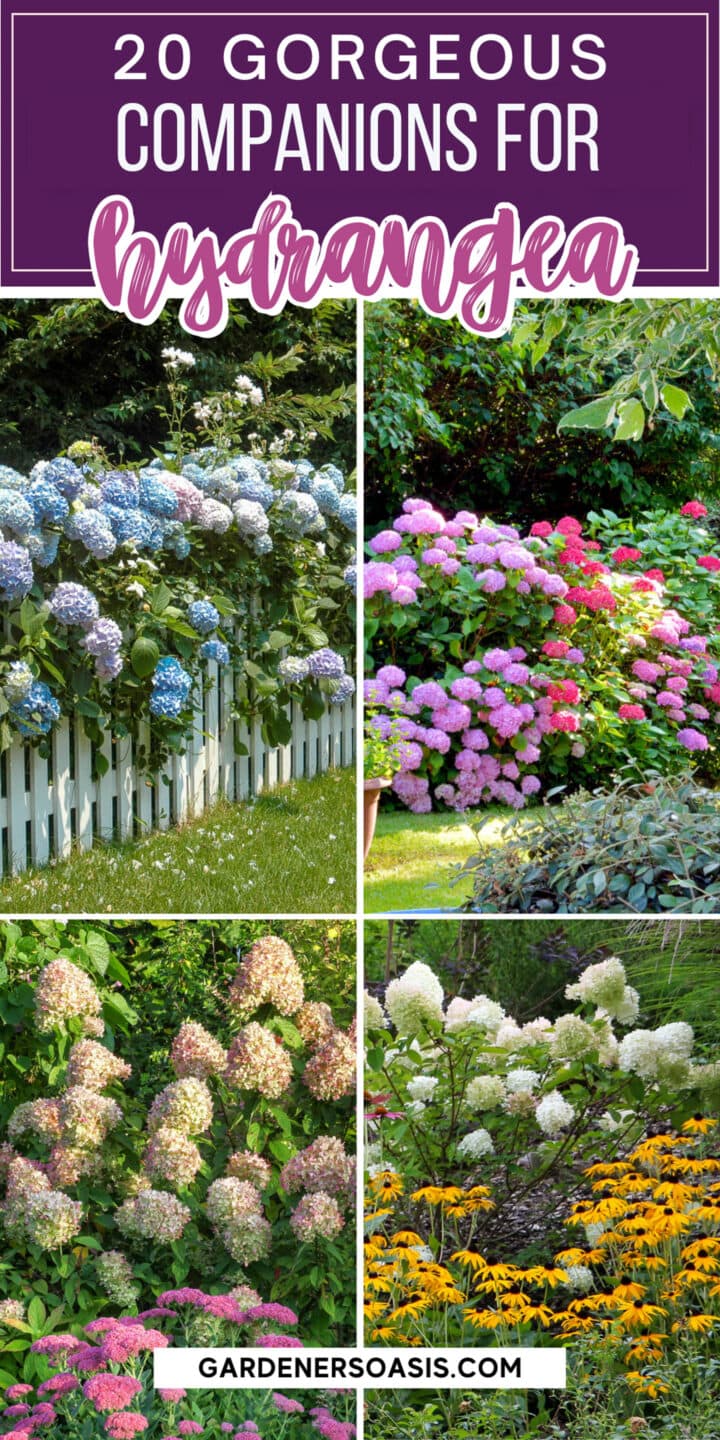Hydrangea Companion Plants
If you’re looking for the perfect Hydrangea companion plants, you’ve come to the right place. From perennials and shrubs to ground covers and climbers, these are the best sun-loving companions and shade-compatible allies to grow with Hydrangeas.
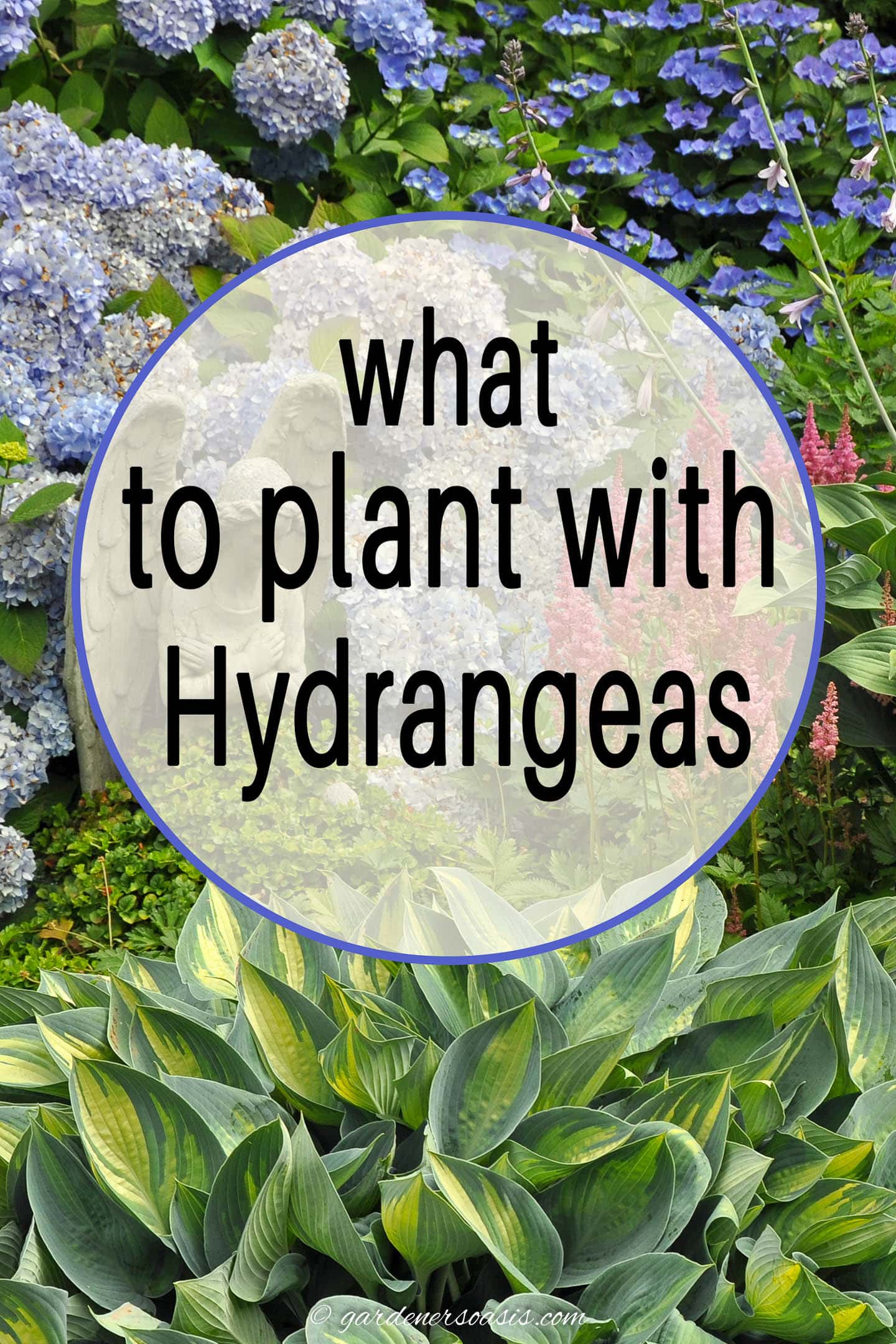
Hydrangeas have long been a favorite among gardeners because of their large, opulent blooms and lush foliage.
But every plant can be enhanced by sharing the stage with suitable companions.
Choosing the right companion plants can dramatically elevate your garden’s aesthetic appeal and extend the blooming season.
But sometimes it can be hard to decide what other plants will thrive and look good with Hydrangeas.
Since I have many different varieties growing in my garden, I have had lots of experience trying to figure out what works best with them.
And I thought I would share my favorite Hydrangea companion plants.
Fortunately, there are lots of options!
inspiration here for your next garden project.
How to choose companion plants?
Before we start, I thought I’d go over the basics of how to choose companion plants.
The very first step is to know what type of Hydrangea you have.
Some of them like sun. And some like shade.
So the types of companion plants that will be successful will vary depending on that.
If you’re not sure what type you have, check out our guide to the different types of Hydrangeas and how to identify them.
Once you know the type, there are 3 main factors to consider when choosing successful companion plants:
- Similar Growing Conditions – Choosing plants that thrive in the same growing conditions as your Hydrangea means they will grow in the same soil pH and require similar watering, fertilizing and pruning maintenance. Which makes your job easier and the plants happier.
- Visual Contrast – Using plants with different leaf or flower shapes and different foliage or bloom colors will provide contrast that make your garden look more interesting.
- Seasonal Interest – You can either find plants that bloom at the same time as your Hydrangeas, which provides a complementary color scheme. Or extend the season by finding plants that provide interest when Hydrangeas don’t (whether that’s by flowering at a different time or with evergreen foliage).
Now that you know what to look for, let’s get on with the Hydrangea companion plants list.
1 | Astilbe
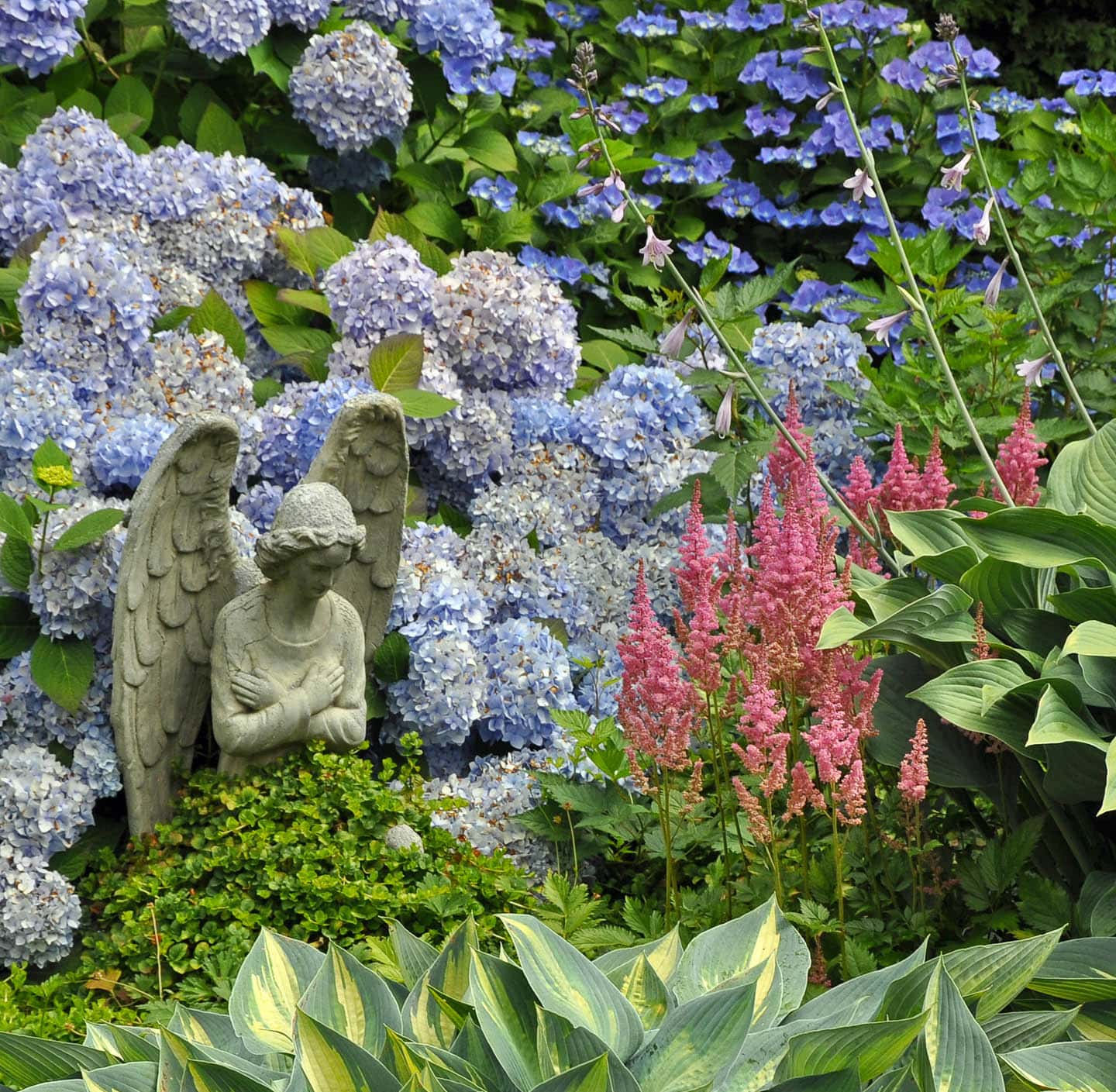
Scientific name: Astilbe
Zones: 3 to 9 (depending on the variety)
Exposure: Shade to sun (depending on the variety)
Height: 18″ to 48″ (depending on the variety)
Width: 18″
Bloom Time: Early to mid summer
Bloom color: Pink, red, white
Astilbe has feathery, plume-like blooms that provide a beautiful textural contrast to the large, rounded hydrangea blooms. This helps to add visual interest and depth to your garden.
Smaller varieties create a nice layered effect when planted in front of Hydrangeas.
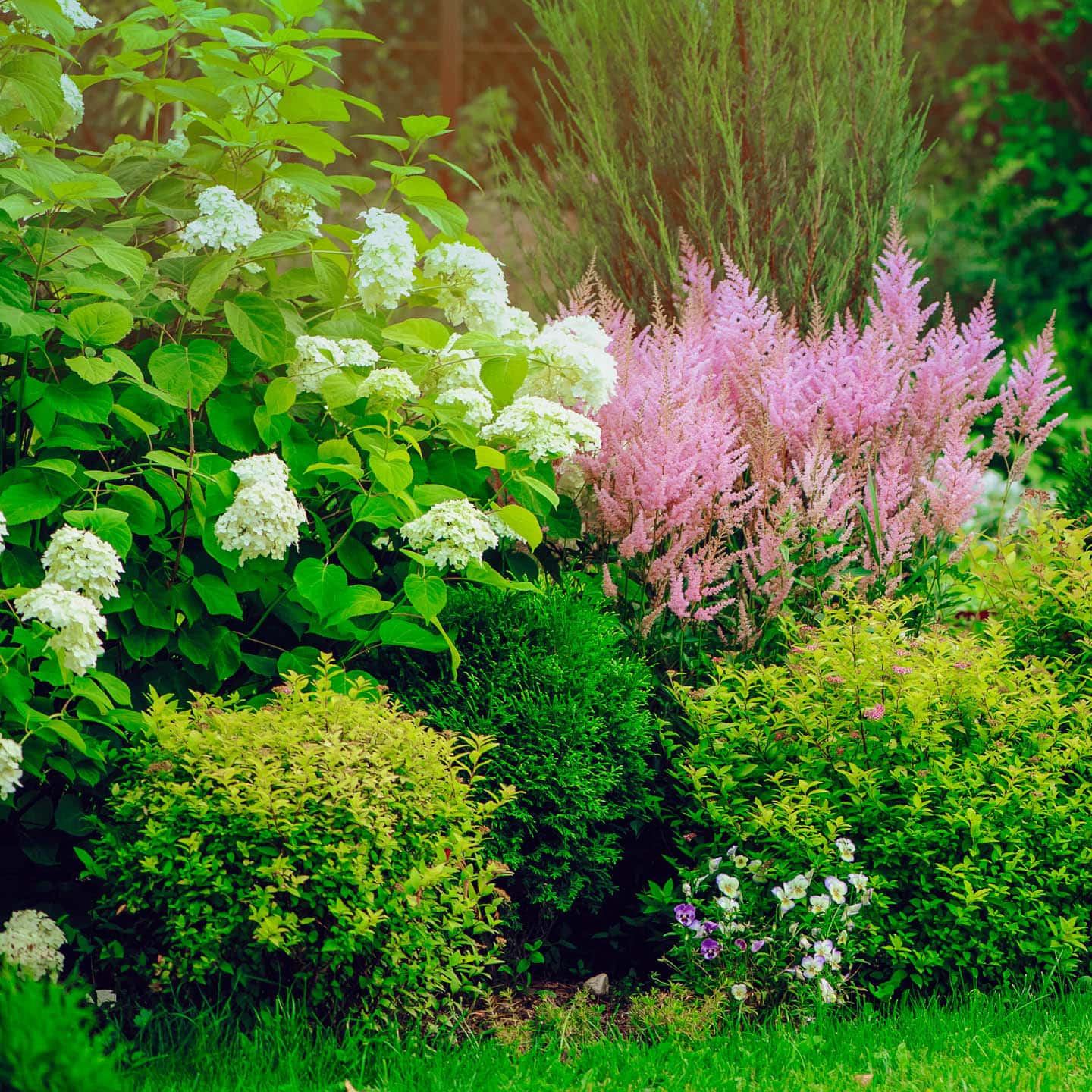
Larger ones can be used as filler around the shrubs.
Astilbe has varieties that do well in both sun and shade so make sure you get the right ones for your conditions.
2 | Hostas
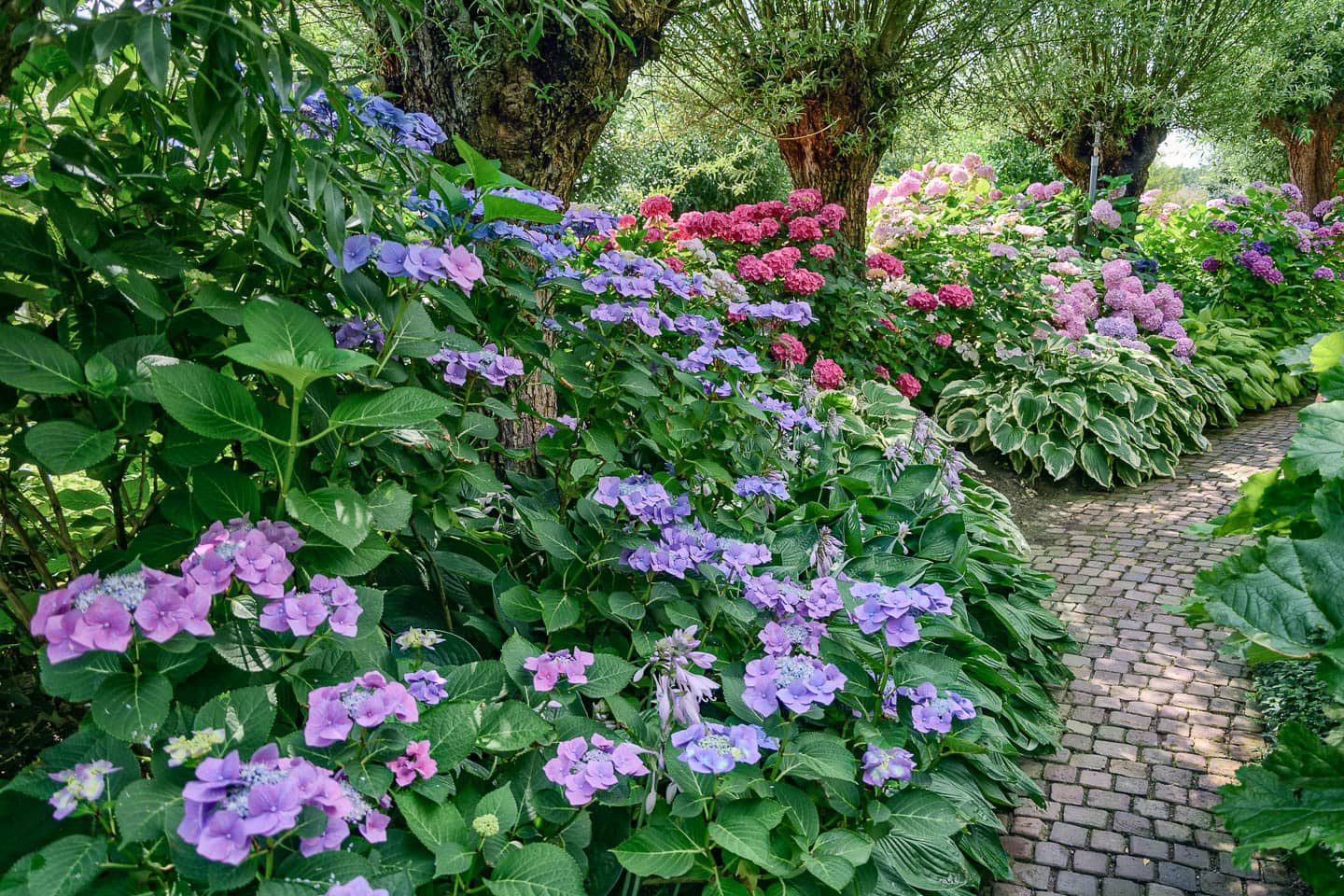
Scientific name: Hosta
Zones: 3 to 9
Exposure: Shade to Part Shade
Height: 4 inches to 5 feet (depending on the variety)
Width: 6 inches to 6 feet (depending on the variety)
Bloom time: late spring or summer
Bloom color: white, purple, yellow
Hostas are an easy-to-grow perennial that can be planted with both shade and sun Hydrangeas in slightly different ways.
When planting in part shade or shade, smaller Hostas make great border companion plants in front of the Hydrangeas. Larger Hostas can be planted beside or behind the Hydrangea as filler.
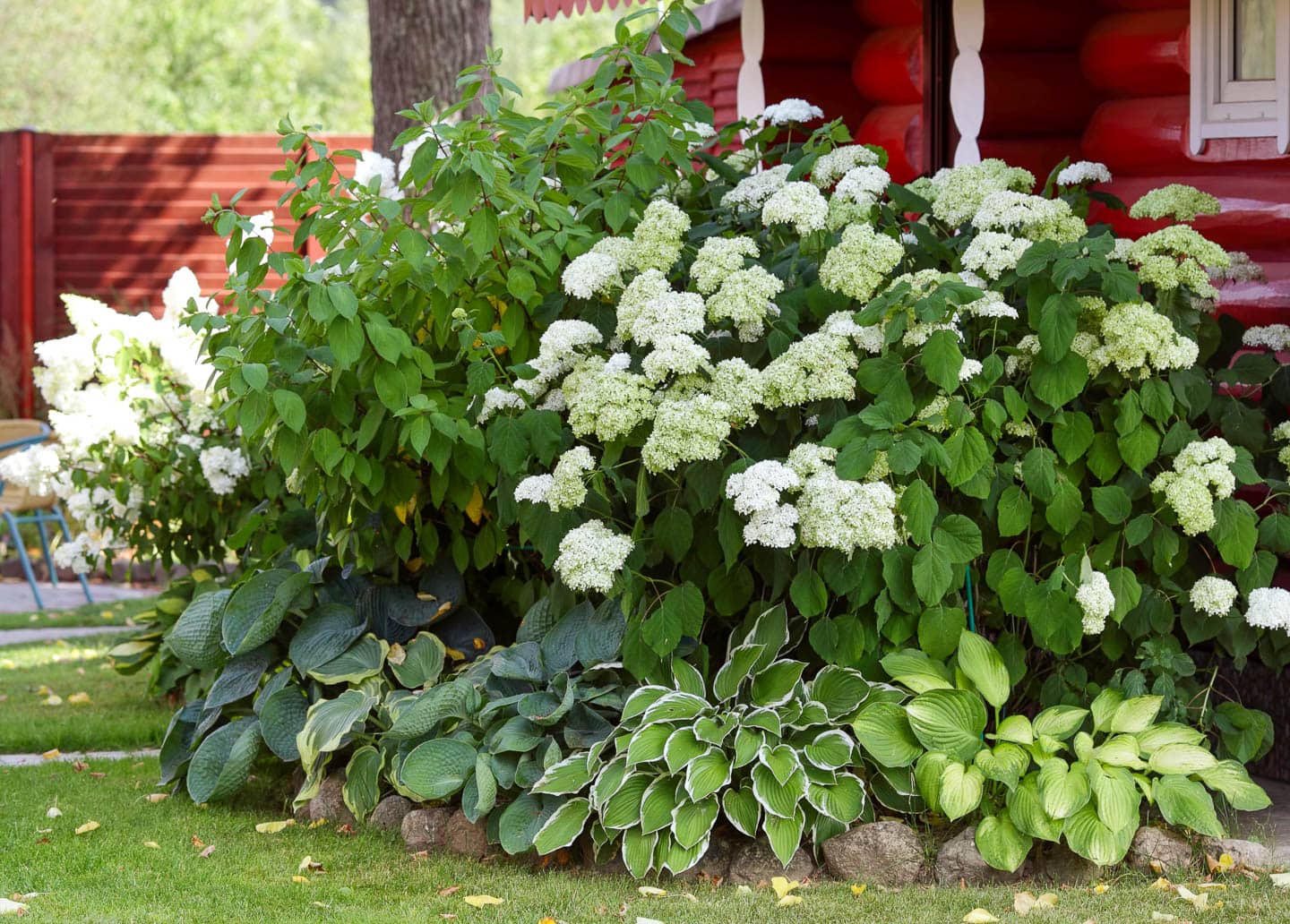
If your Hydrangea is growing in the sun, provide some shade for the Hostas by planting small to medium-sized ones under the shrub. Also, look for ones that have yellow leaves, which generally tolerate sun better than other Hosta varieties.
In either case, Hostas create a fuller, more lush look and act as a living mulch, covering the ground around the shrubs.
This can help to suppress weeds, retain soil moisture, and maintain a more stable soil temperature, all of which can contribute to the overall health of the hydrangeas.
They come in a wide range of sizes, colors, and leaf patterns, so you should be able to find a few that you like.
3 | Sedge
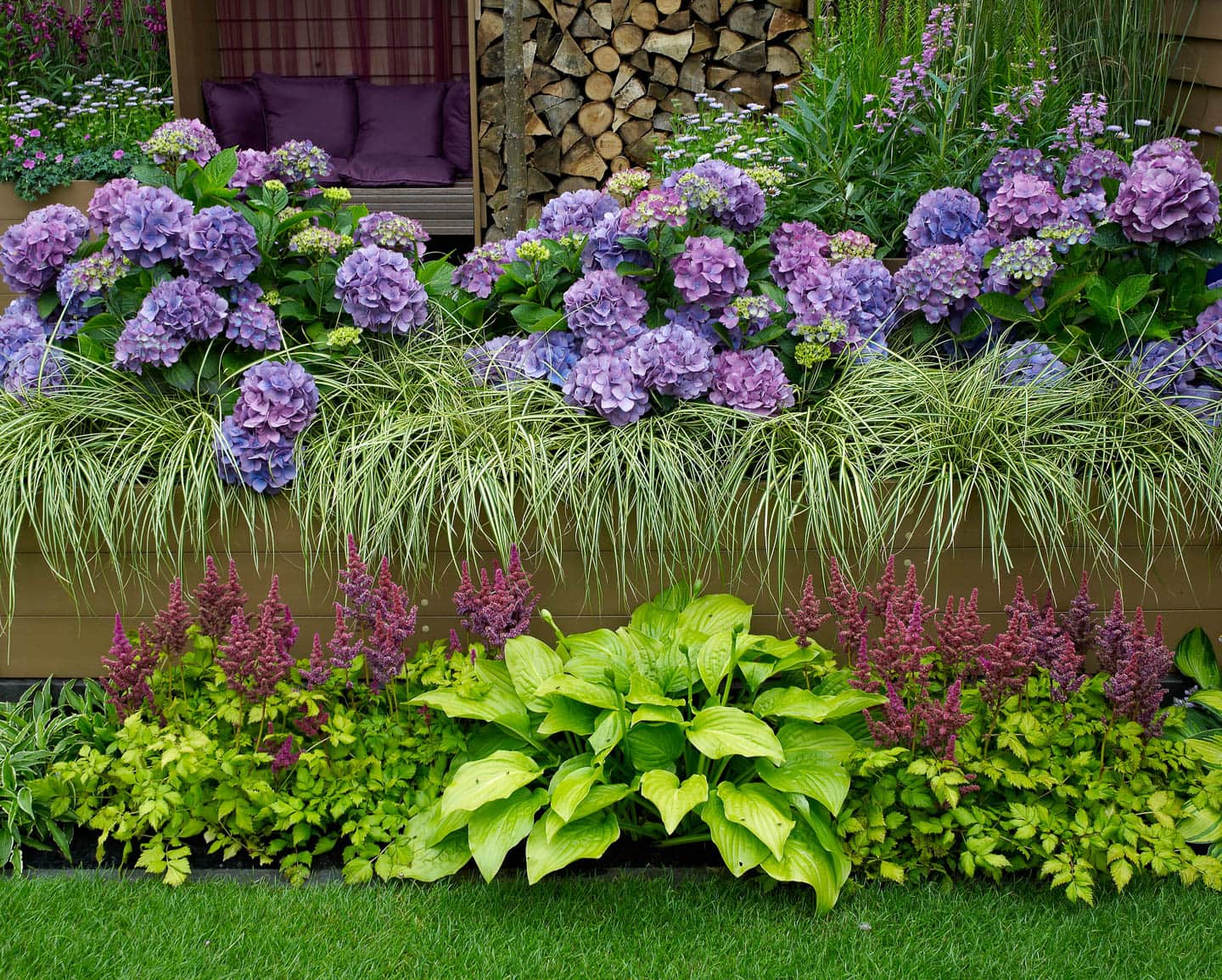
Scientific name: Carex, C. morrowii
Zone: 5 to 9
Exposure: partial sun, shade
Height: 9″ – 12″
Width: 12″ – 18″
Bloom time: insignificant brown
Bloom color: beautiful foliage — dark green, yellow, bronze, variegated
Sedge is a grass-like perennial that grows best in shade to part shade and makes a great border plant in front of Hydrangeas. This creates a nice layered effect that also helps to cover the base of the shrub.
The thin leaves have a different form and texture than the large, rounded leaves and blooms of Hydrangeas. This contrast creates a more visually interesting look.
While hydrangeas are deciduous and lose their leaves in the winter, many sedges remain evergreen or semi-evergreen, which adds year-round interest to your garden.
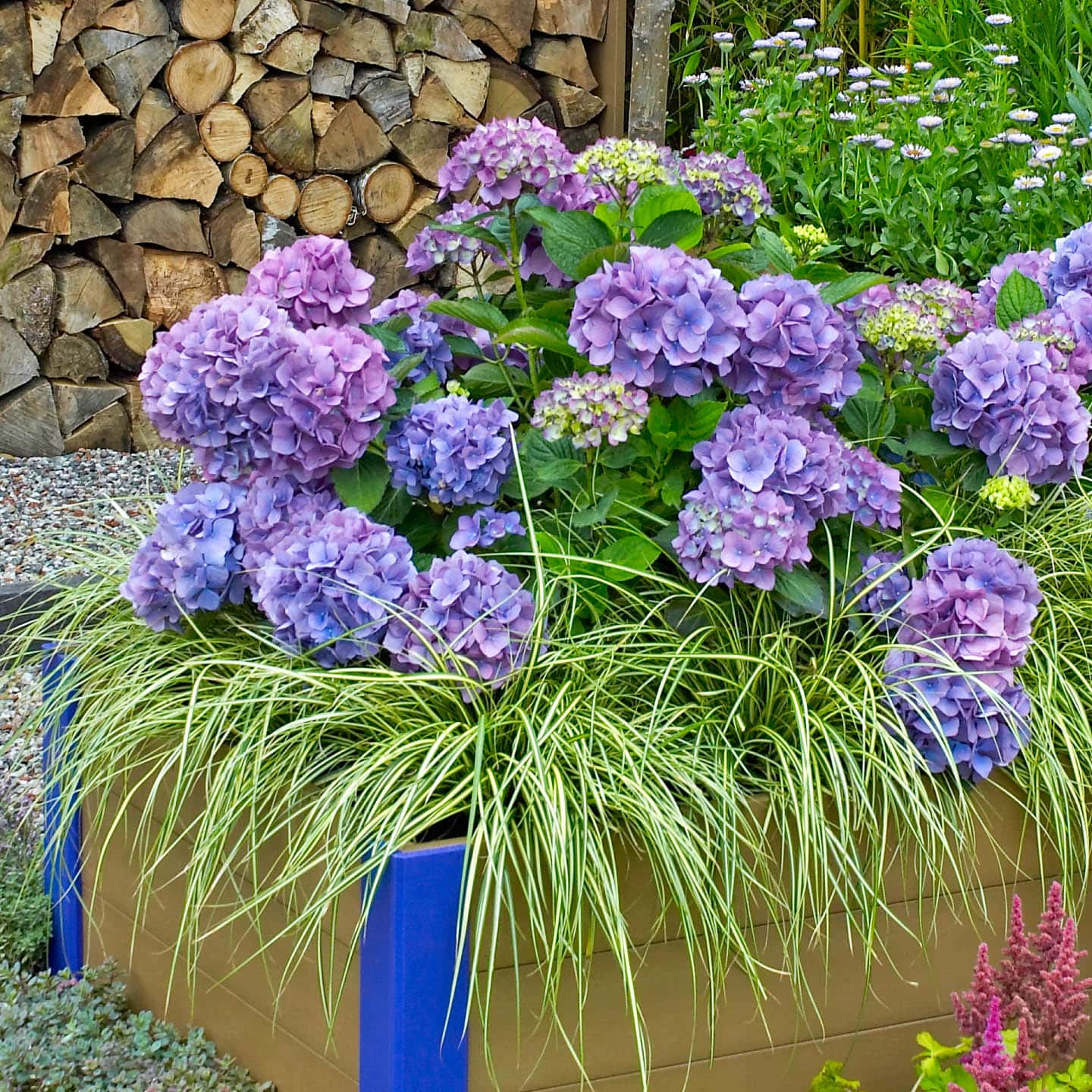
This plant combination also does quite well in containers.
Even better, Sedges are very low maintenance, requiring little more than occasional watering to keep them healthy.
You could also use Japanese Forest Grass for a similar look.
4 | Ferns
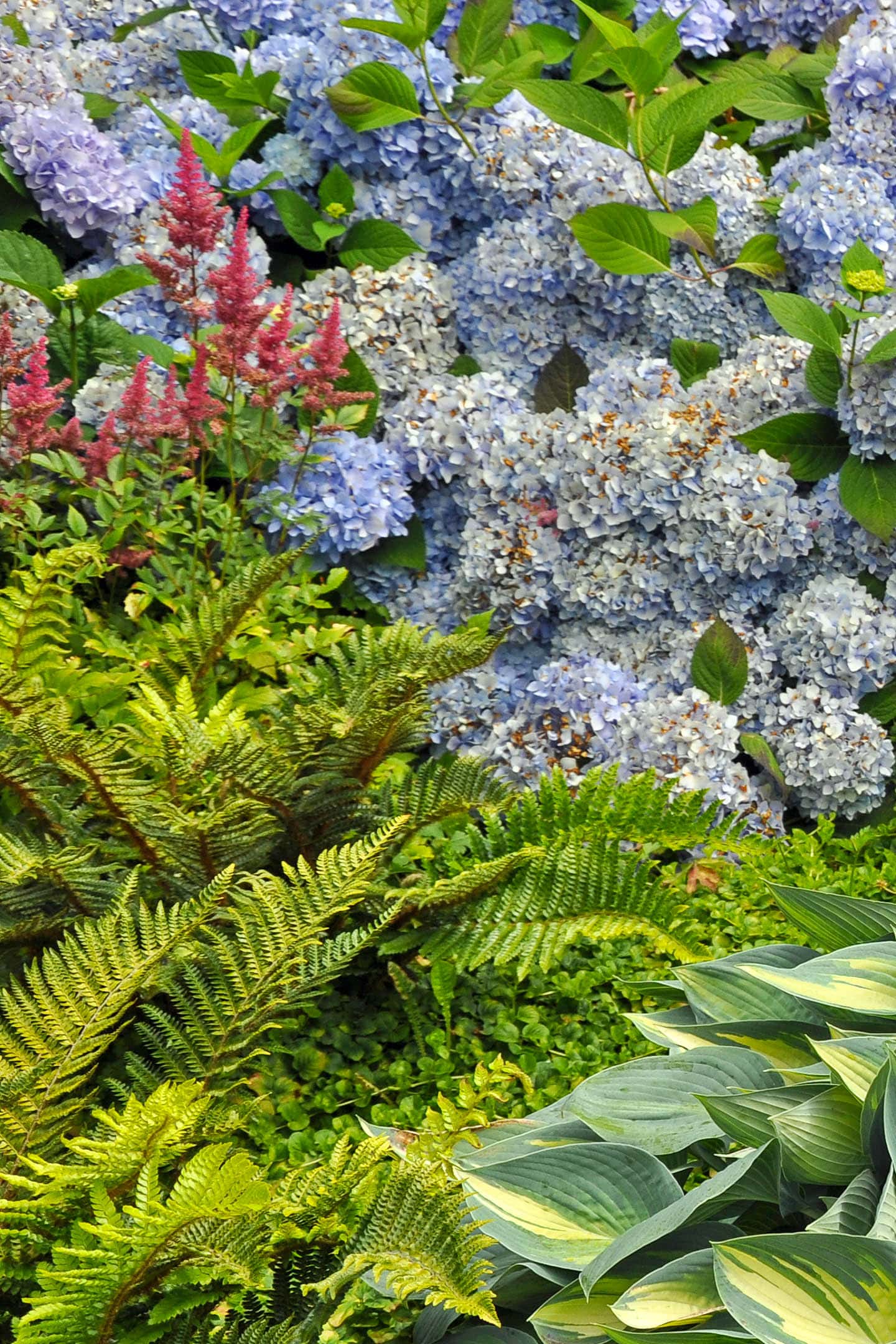
Scientific name: Various
Zone: 3 to 11
Exposure: partial sun, shade
Height:
Width:
Bloom time: None
Bloom color: None
Ferns are another plant that pairs well with Hydrangeas planted in the shade.
While Hydrangeas are known for their large, showy blooms, ferns are appreciated for their delicate, feathery fronds.
When planted together, the textural contrast between the two plants creates an interesting look.
If you’re aiming for a woodland or natural-looking garden, this combination of Hydrangeas and Ferns can help to create that aesthetic, as both are commonly found in forest understory habitats.
5 | Coral bells
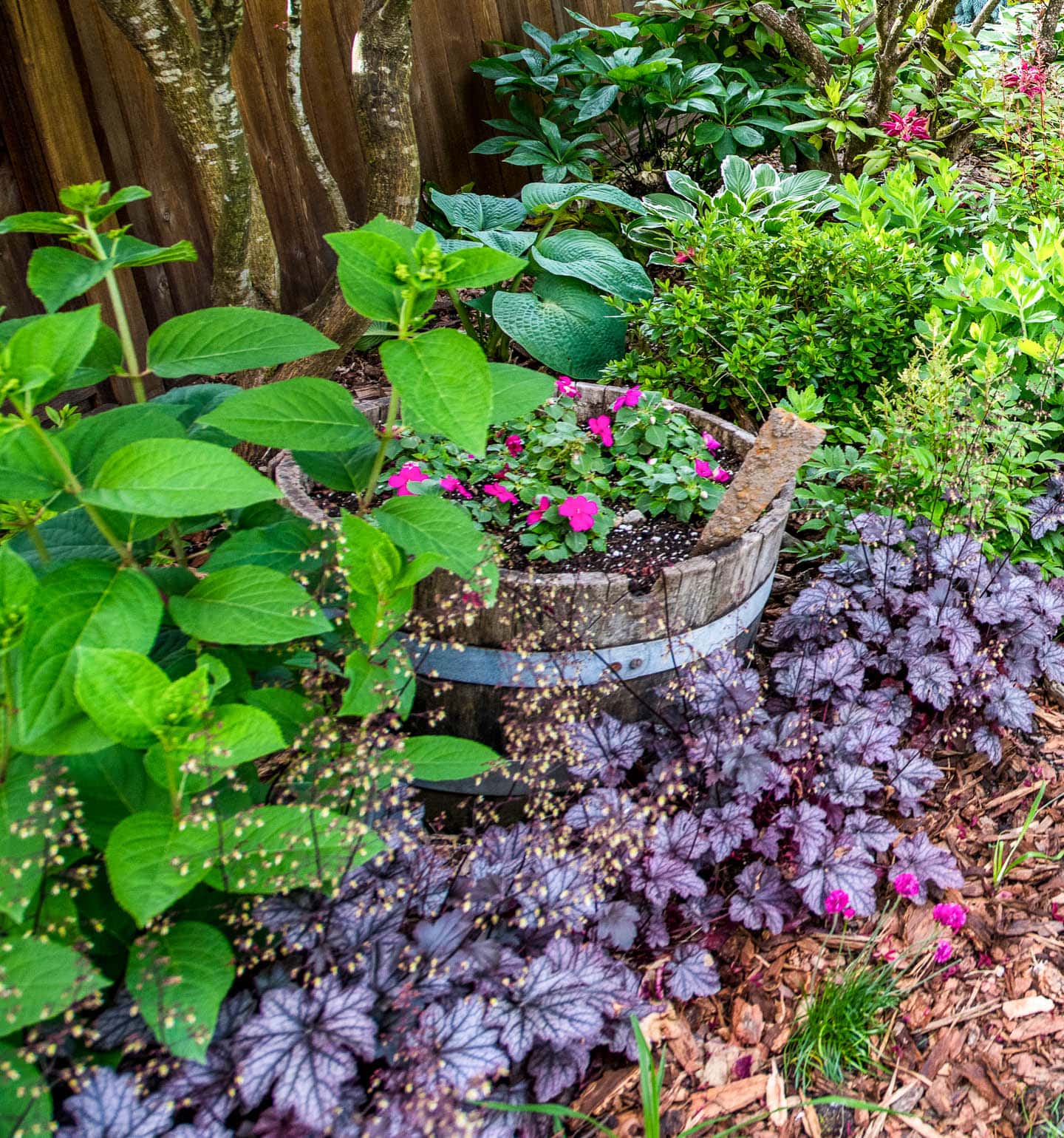
Scientific name: Heuchera
Zone:
Exposure: partial sun, shade
Height: 6″ to 12″
Width: 8″ to 16″
Bloom time: Late spring to summer
Bloom color: Pink, white
Coral Bells are an evergreen, low-growing perennial that can be planted under both sun and shade Hydrangeas.
It is known for its vibrant and varied foliage, which can range from bright lime green to deep burgundy or purple.
This provides a beautiful color contrast against the green foliage and vibrant blooms of hydrangeas.
There are numerous varieties of Heuchera available, each with its own unique combination of leaf and flower so you can choose the perfect variety to compliment your specific Hydrangea.
6 | Daisies
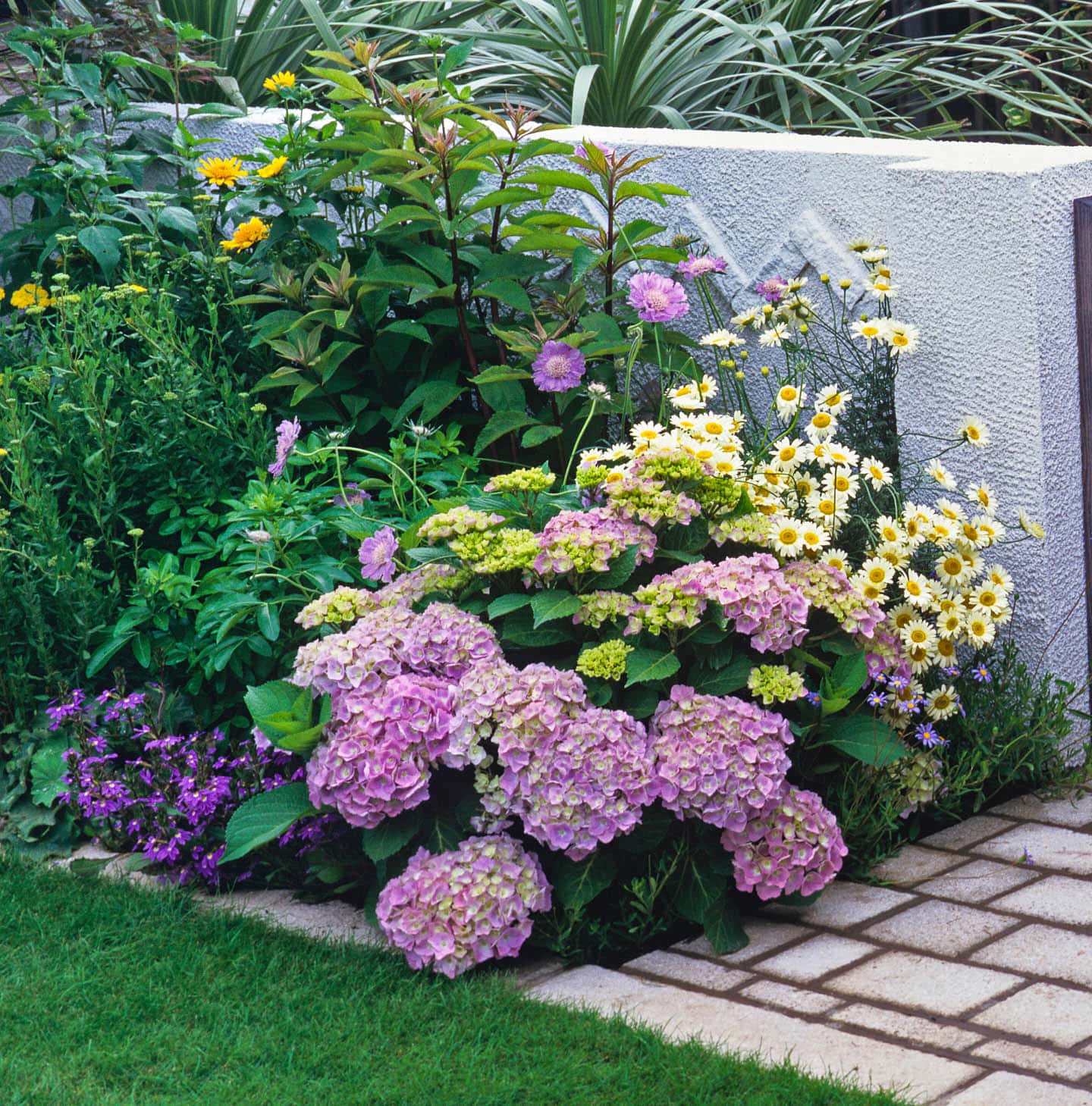
Botanical name:
Zones: 5 to 9
Sun: Full sun
Height: 6″ to 24″
Width: 12″ to 24″
Flower color: White
Daisies are a good plant pairing for Hydrangeas that are planted in the sun.
They have a simpler, more individual flower structure that adds visual diversity to your garden.
Depending on the variety, daisies can have a long blooming period that spans from late spring into fall.
This helps to ensure that there are flowers in your garden even when your Hydrangeas are not in bloom.
7 | Delphiniums
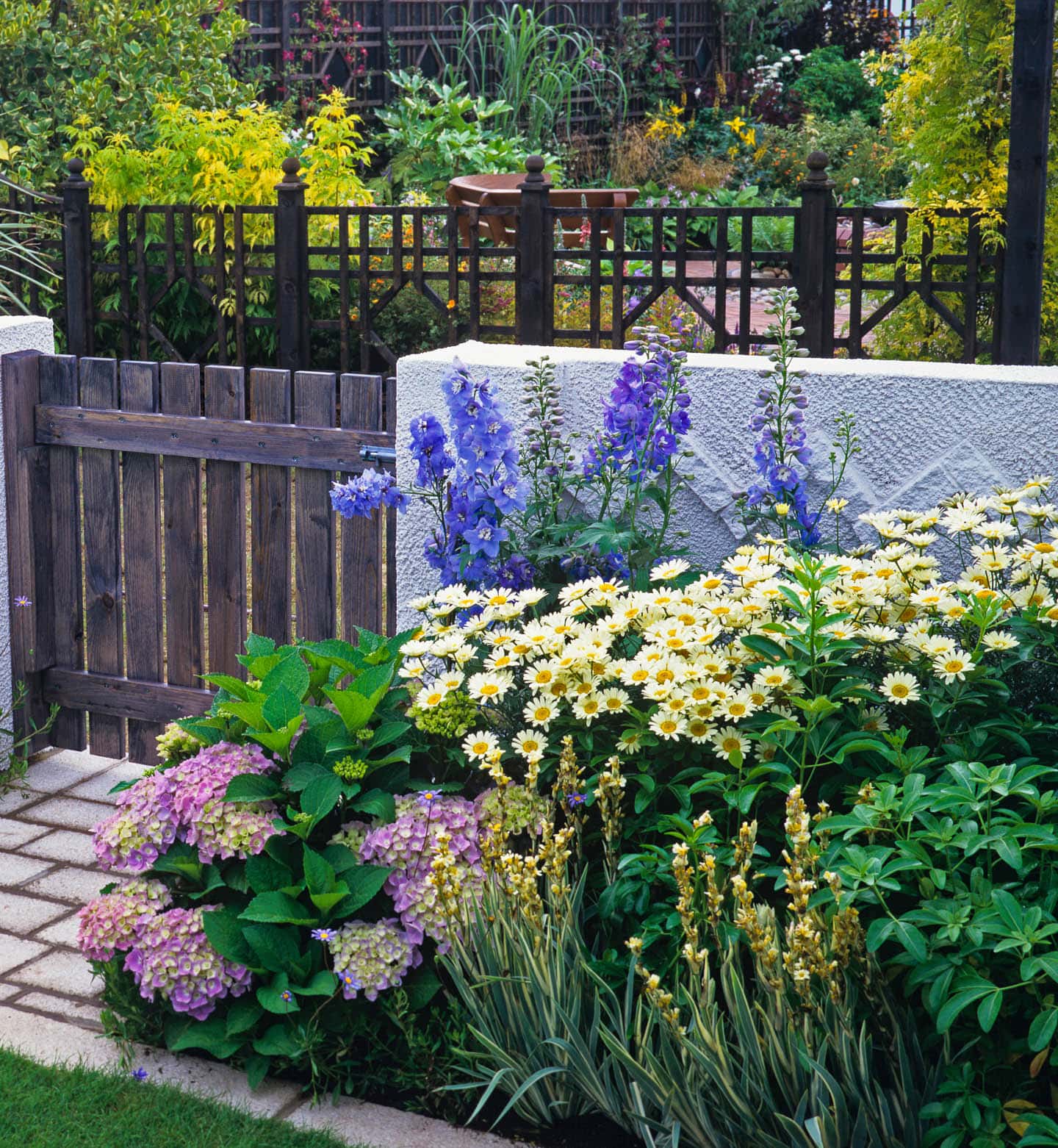
Scientific name: Delphinium
Zone: 3 to 7
Exposure: Sun, part shade
Height: 1′ to 3′
Width: 1′ to 2′
Bloom time: Late spring to summer
Flower color: blue, purple, pink, white
Delphiniums are tall, vertical plants that grow in sun or part shade.
They are known for their vibrant shades of blue that beautifully complements the range of Hydrangea colors.
Delphiniums typically bloom in early to mid-summer, which coincides with the blooming period of many Hydrangea varieties. This creates a spectacular simultaneous bloom display.
However, these perennials often require staking to support their tall flower spikes and are more high-maintenance than some of the other companion plants.
8 | Daylilies
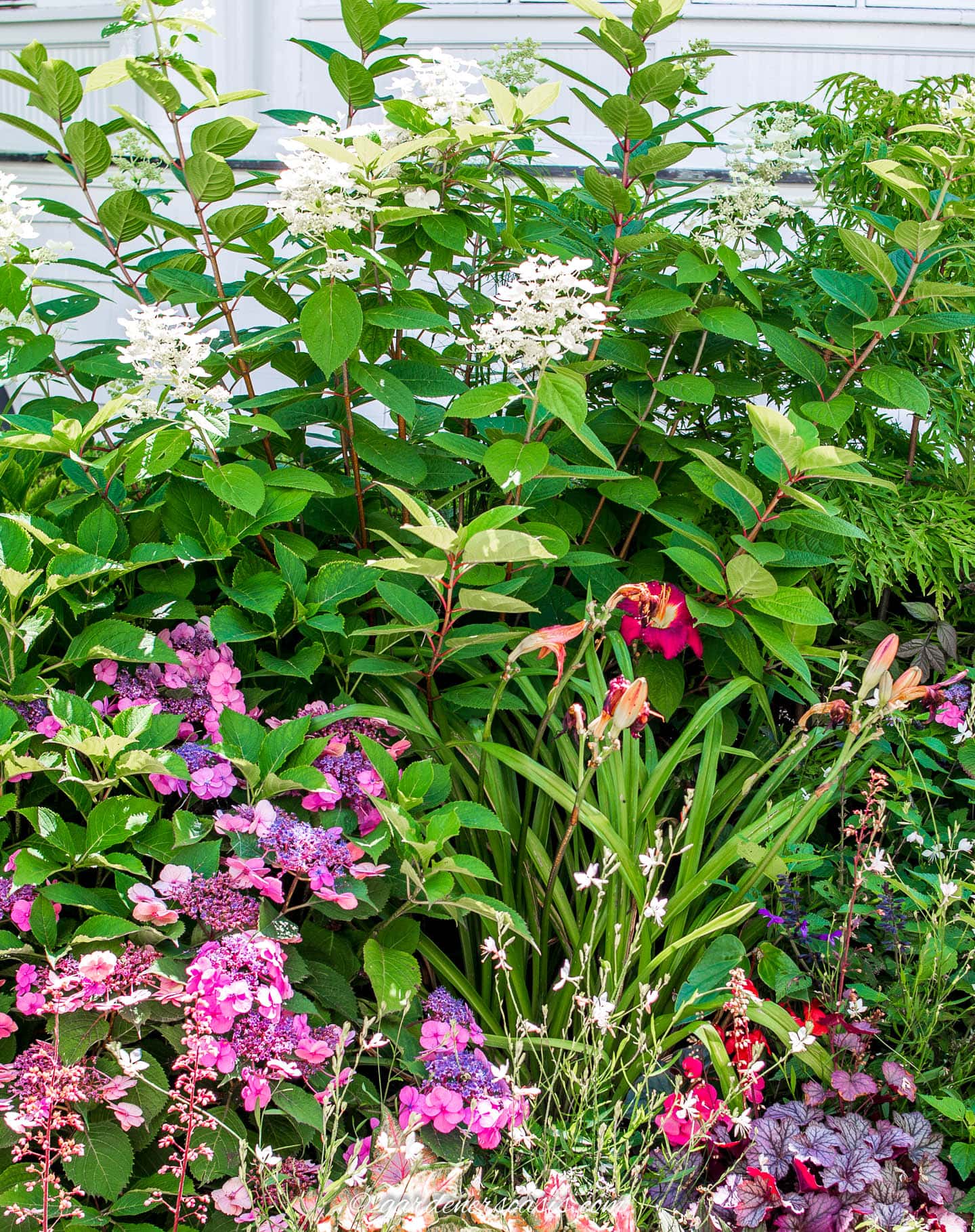
Scientific name: Hemerocallis
Zone: 3 to 9
Exposure: Sun to part shade
Height: 12″ to 36″
Width: 24″ to 36″
Bloom time: Late spring to summer
Flower color: pink, purple, red, yellow
Daylilies are a low-maintenance perennial that blooms best in full sun, but can be grown in part shade.
Depending on the variety, these perennials flower from late spring to late summer. This adds an extended blooming period of continuous color to your garden.
They also come in a wide range of colors, from yellow and orange to pink, red, and purple. Which gives you a lot of flexibility to create a color scheme that complements your Hydrangeas.
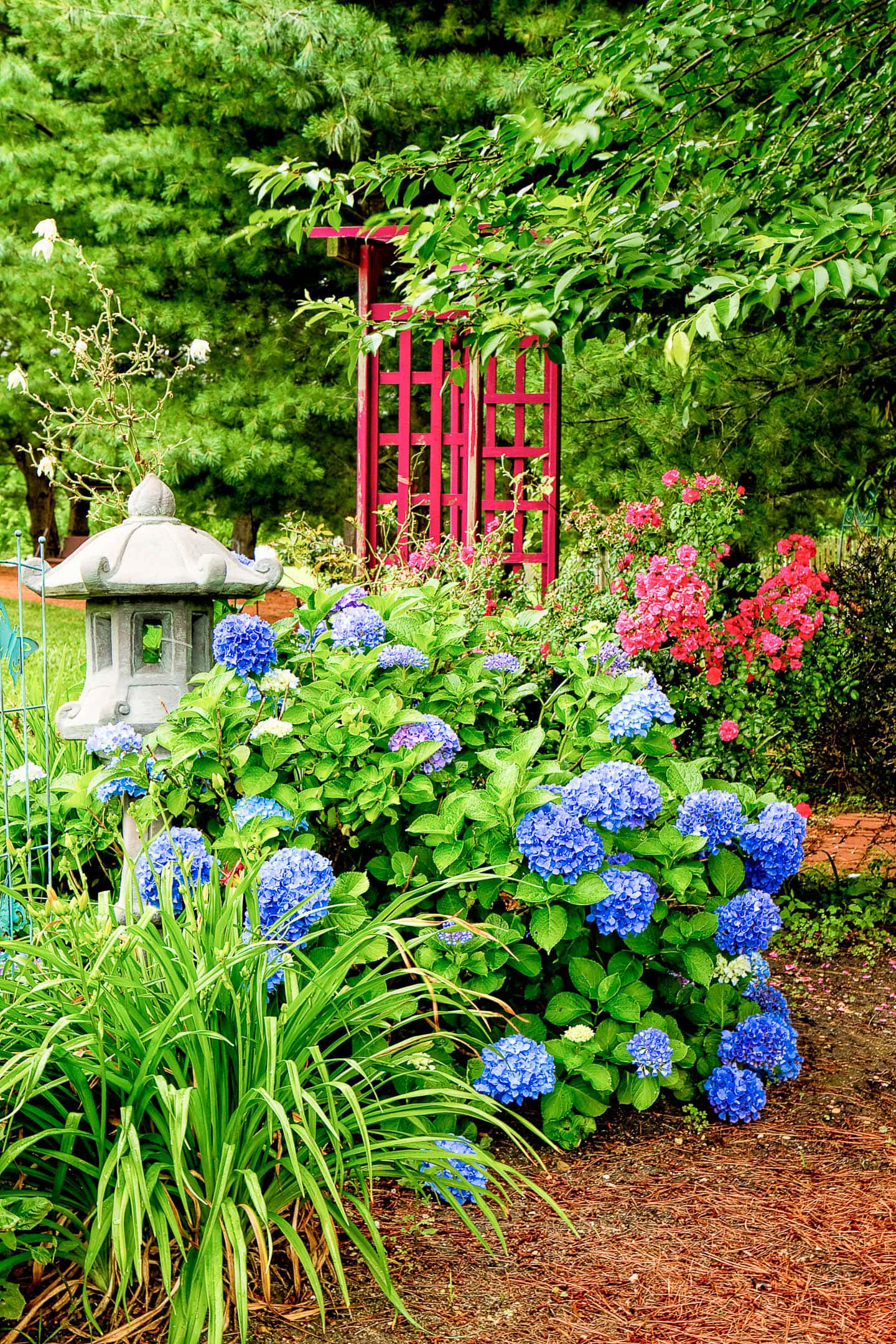
However, their more upright, grass-like form provides a nice contrast to the round, bushy form of hydrangeas even when the Daylilies aren’t blooming.
9 | Sedum ‘Autumn Joy’
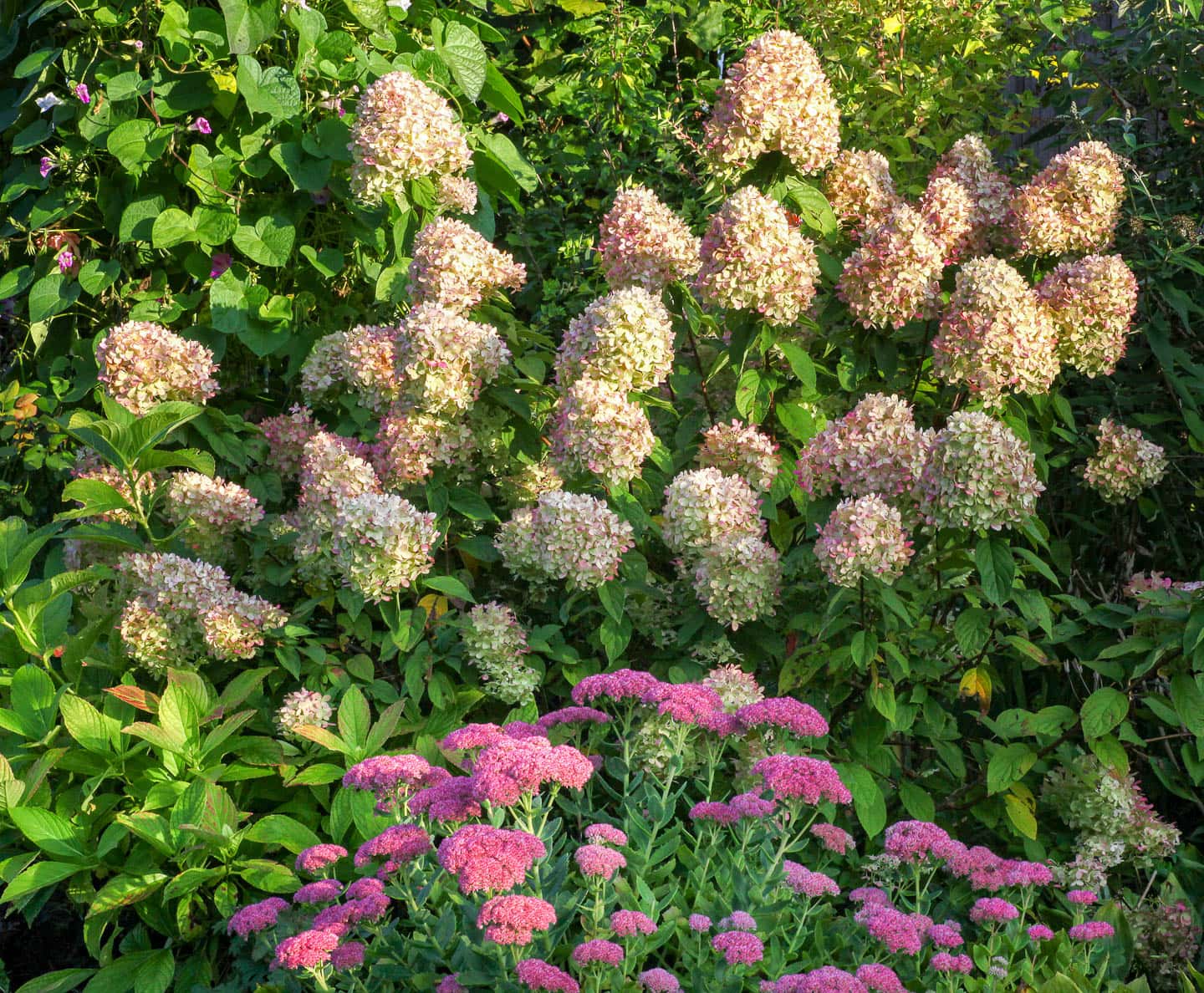
Botanical name: Sedum spectabile
Zones: 3 to 11
Exposure: Full to part sun
Height: 18″ to 24″
Width: 24″ to 36″
Bloom time: Late summer to fall
Flower color: Pink
Sedum ‘Autumn Joy’ is a sun-loving perennial with pink to bronze flowers that blooms in late summer to fall.
This perennial has smaller, succulent-like leaves and flat, plate-like flower heads that provide a contrast in texture with the large round Hydrangea leaves and blooms.
Both the color of its flowers and its blooming season make it a great plant pairing for Panicle Hydrangeas.
Plant it in front of the shrub to cover the base and provide layers of color.
10 | Echinacea
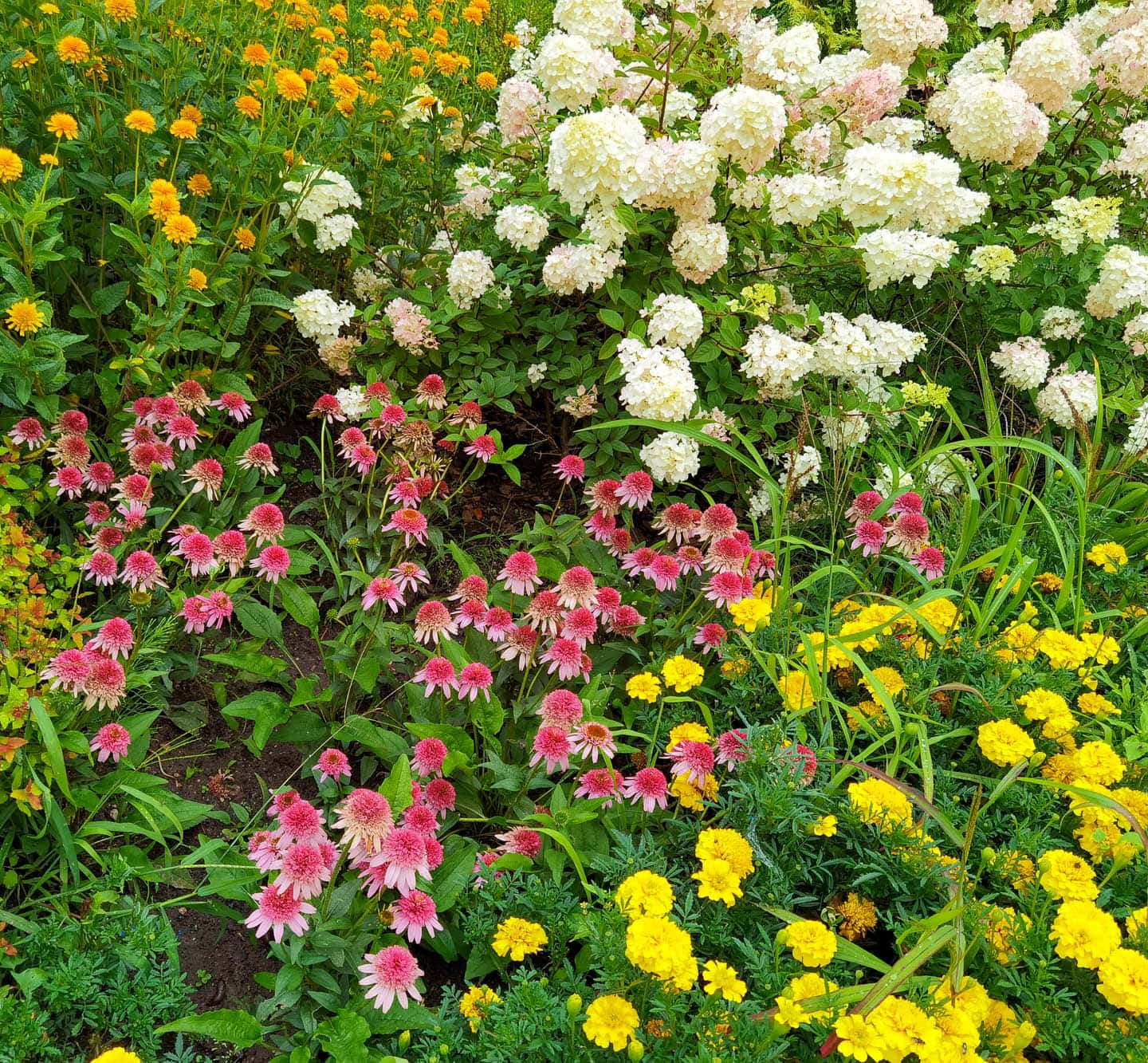
Botanical name: Echinacea
Zones: 3 to 9
Exposure: Full sun to partial shade
Height: 18″ to 36″
Width: 18″ to 24″
Bloom time: Summer
Flower Color: Purple, pink, yellow, orange, red, and white
Echinacea is another perennial that grows and blooms best in full sun. Which makes it a great companion plant for Hydrangea paniculata.
It comes in many vibrant flower colors (depending on the variety) that bloom in the summer and can continue into fall.
These often overlap with the Hydrangea bloom times and provide a nice contrasting pop of color during these seasons.
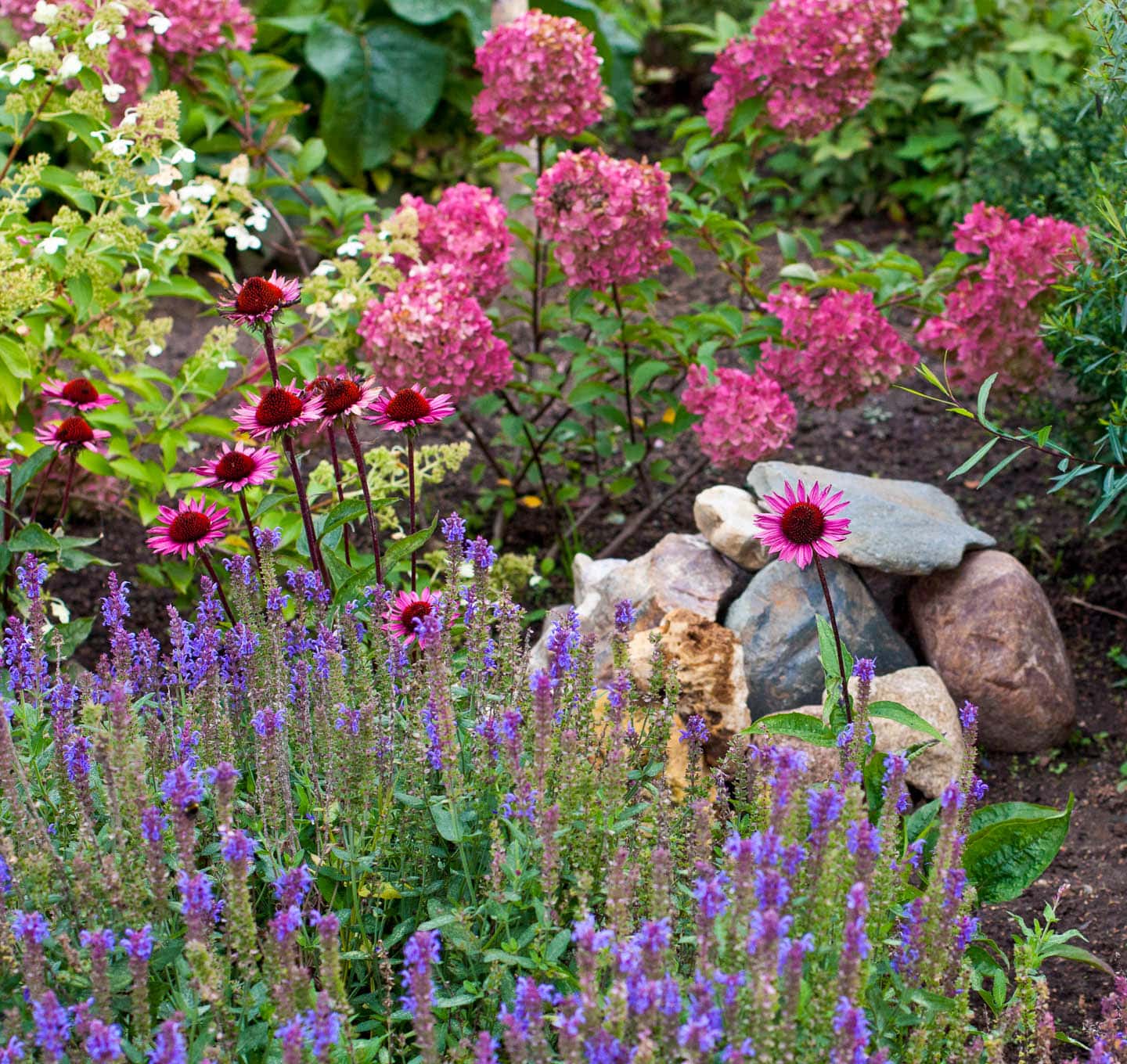
Echinacea plants are usually shorter than Hydrangea paniculata. Planting them in front of the bush creates a pleasing tiered effect.
11 | Black-eyed Susan
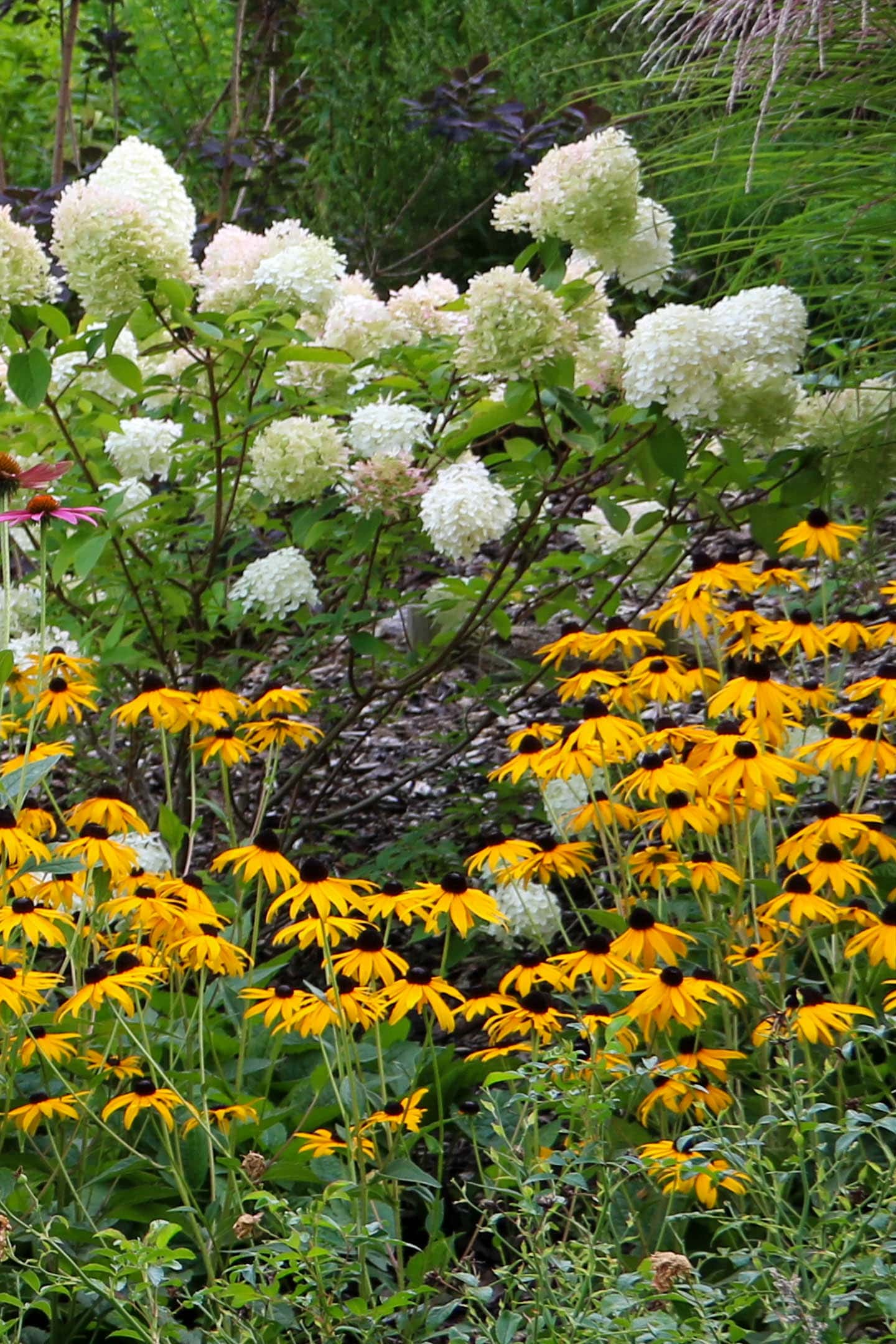
Botanical name: Rudbeckia hirta
Zones: 3 to 7
Sun: Full sun
Height: 1′ to 2′
Width: 3′ to 5′
Bloom time: Summer
Flower color: Yellow
Similar to Echinacea, Black-Eyed Susan is a sun-loving perennial that typically blooms in mid to late summer, making it a good plant pairing for Hydrangea paniculata.
The bright yellow, daisy-like flowers create a stunning contrast with the pink or white Hydrangea blooms.
The large leaves of the hydrangea also contrast nicely with the more slender leaves of the Black-Eyed Susan.
12 | Clematis
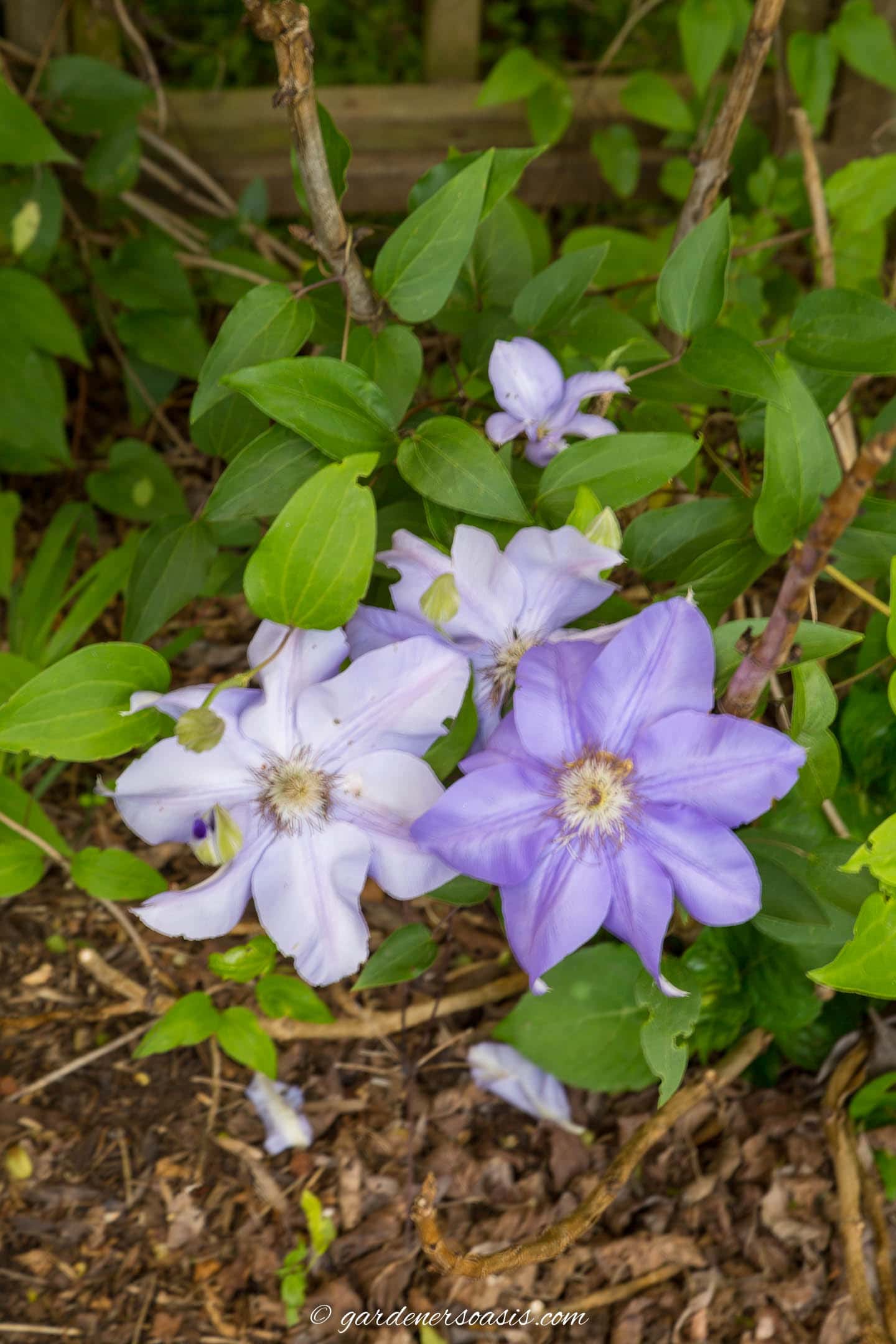
Scientific name: Clematis
Zones: 4 to 9
Exposure: Part Shade to ssun
Height: 3′ to 15′ (depending on the variety)
Width: 3′ to 6′
Bloom Time: Spring, summer or fall (depending on the variety)
Bloom color: White, pink, red, blue, purple
Clematis is a perennial vine with colorful flowers that can appear anytime between spring and fall, depending on the variety.
So you can either find one that blooms before or after your Hydrangea, which provides continuous blooms throughout the growing season.
Or get one that blooms at the same time as your Hydrangea to create an spectacular show all at once.
Similarly, they come in a variety of colors which can either contrast with or match the color of your Hydrangeas.
You can train Clematis to climb a trellis behind your Hydrangea, which adds a vertical layer to your garden design.
Or let it ramble through the shrub. Since they are a light weight and non-invasive vine, they won’t hurt your bush. (The one exception is autumn Clematis which will take over).
13 | Roses
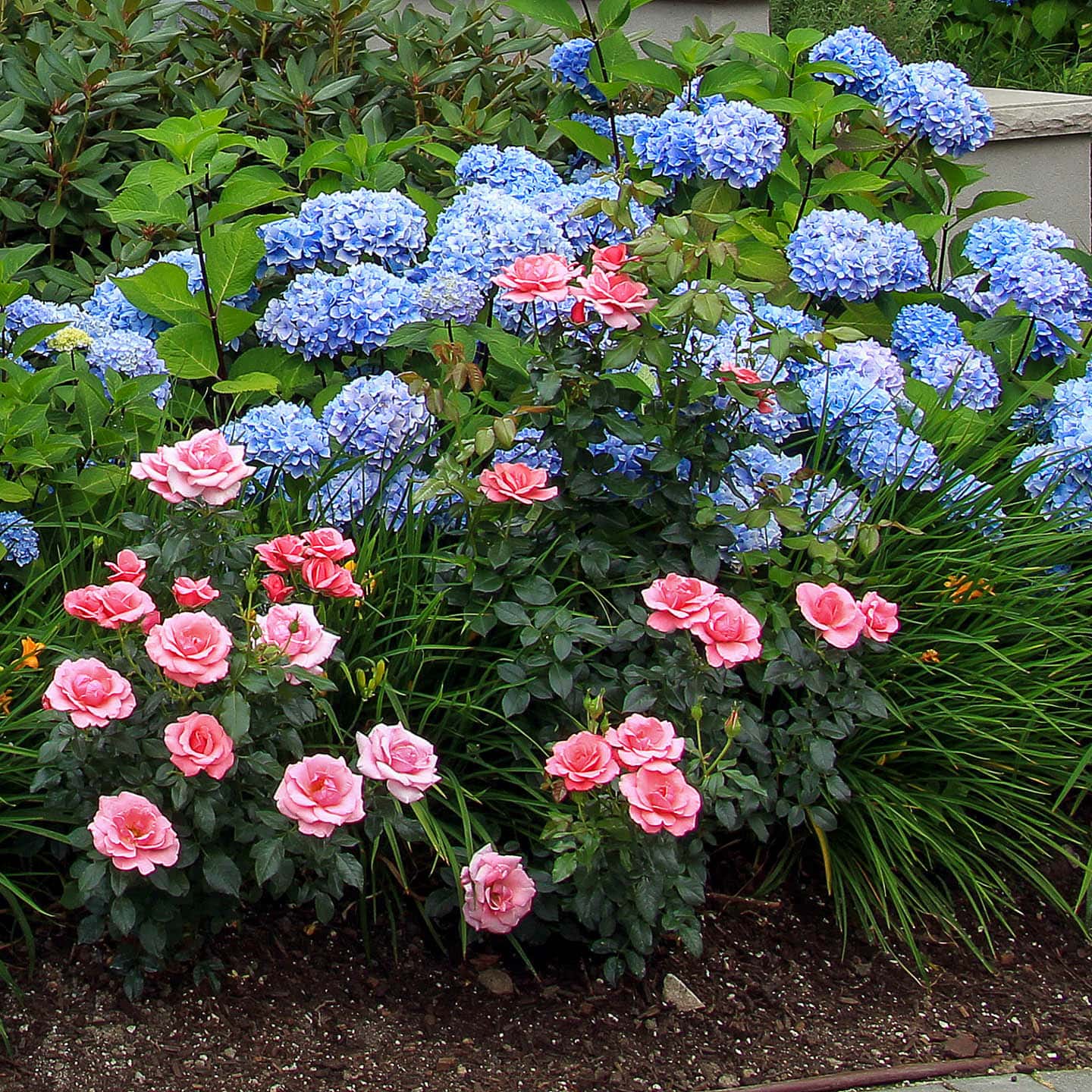
Zones: 3 to 10
Exposure: Full sun to partial shade
Height: 6 inches to 50 feet (depending on the variety)
Width: 12 inches to 12 feet (depending on the variety)
Bloom time: Spring through summer
Bloom color: pink, white, red, yellow, blue, mauve
Roses are a small shrub that grow best in full sun, making them a good companion plant for Hydrangea paniculata.
They come in a wide range of colors that can either complement or contrast with the color of Hydrangeas, depending on the look you’re going for.
They also have fragrance which most Hydrangeas don’t have.
Many modern rose varieties are repeat bloomers, meaning they’ll bloom multiple times throughout the growing season. This adds color to your garden for a longer duration.
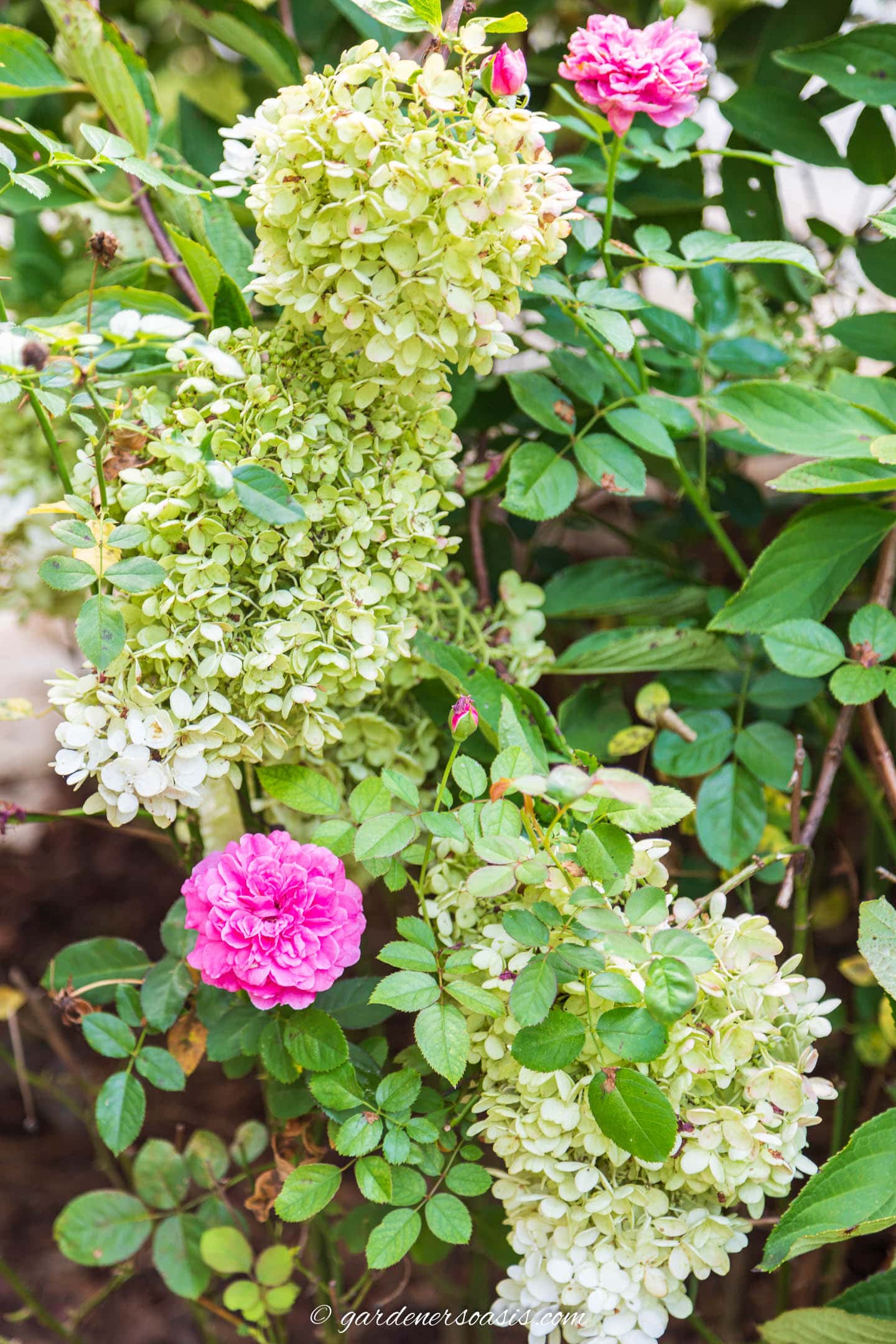
Both roses and hydrangeas have a traditional, romantic appeal. If you’re going for a classic garden aesthetic, this pairing can be a great choice.
Roses generally require more care and maintenance than many other plants, including regular pruning and monitoring for pests and diseases.
14 | Boxwood
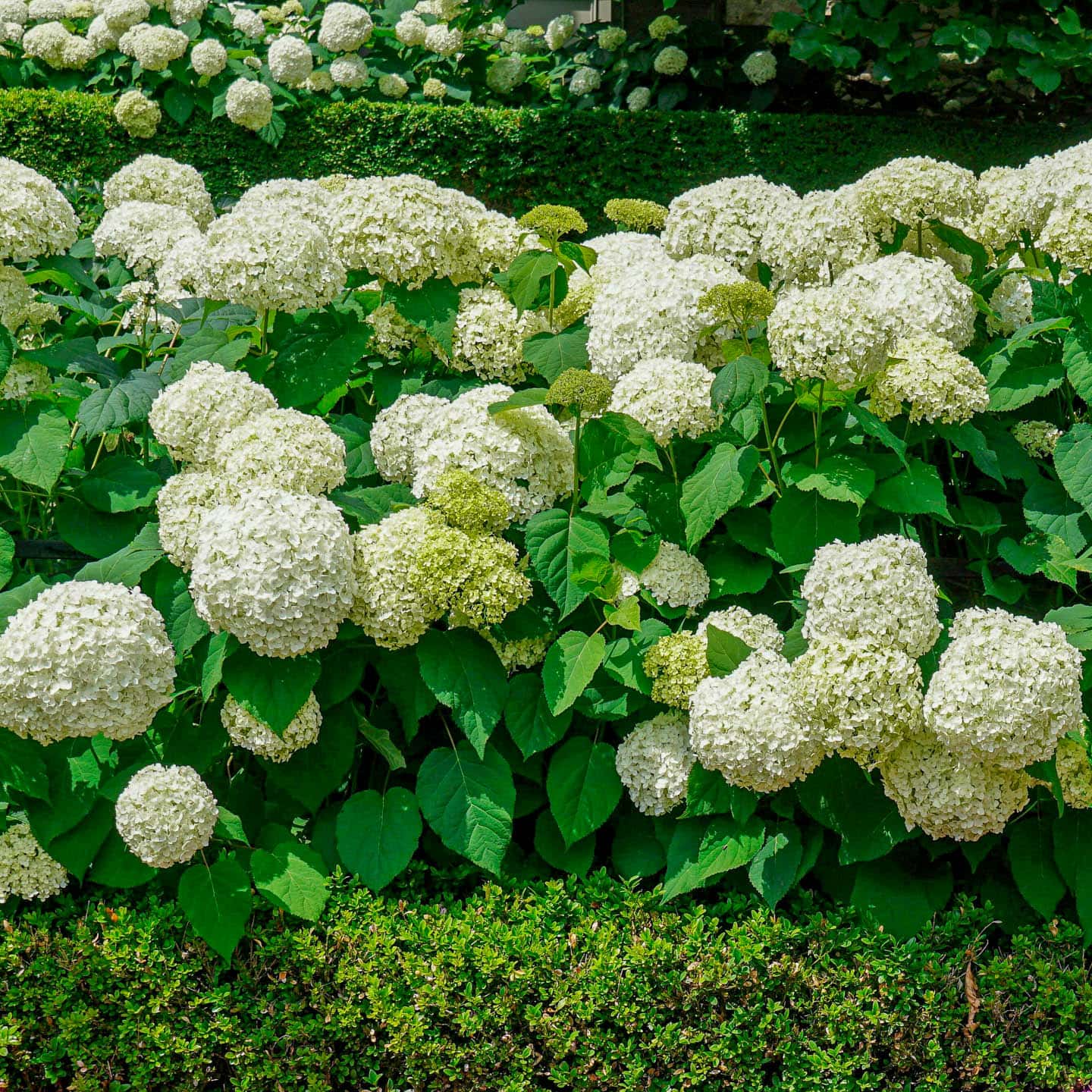
Scientific name: Buxus
Zones: 4 to 10
Exposure: Shade to Sun
Height: 1′ to 12′ (depending on the variety)
Width: 2′ to 8′
Bloom Time: Foliage only
Boxwoods are evergreen shrubs that add year-round structure and form to your garden.
Their small, glossy, dark green leaves provide a nice contrast to the larger, lighter green leaves and bright blooms of Hydrangeas. This creates visual interest and depth in your landscape design.
If you’re aiming for a more formal garden aesthetic, boxwood hedges and hydrangeas are a classic combination.
In this case, pruned Boxwoods are typically used to outline a garden bed that contains the more natural looking Hydrangeas, creating a layered effect.
These shrubs do require regular pruning to maintain their shape.
15 | Japanese maples
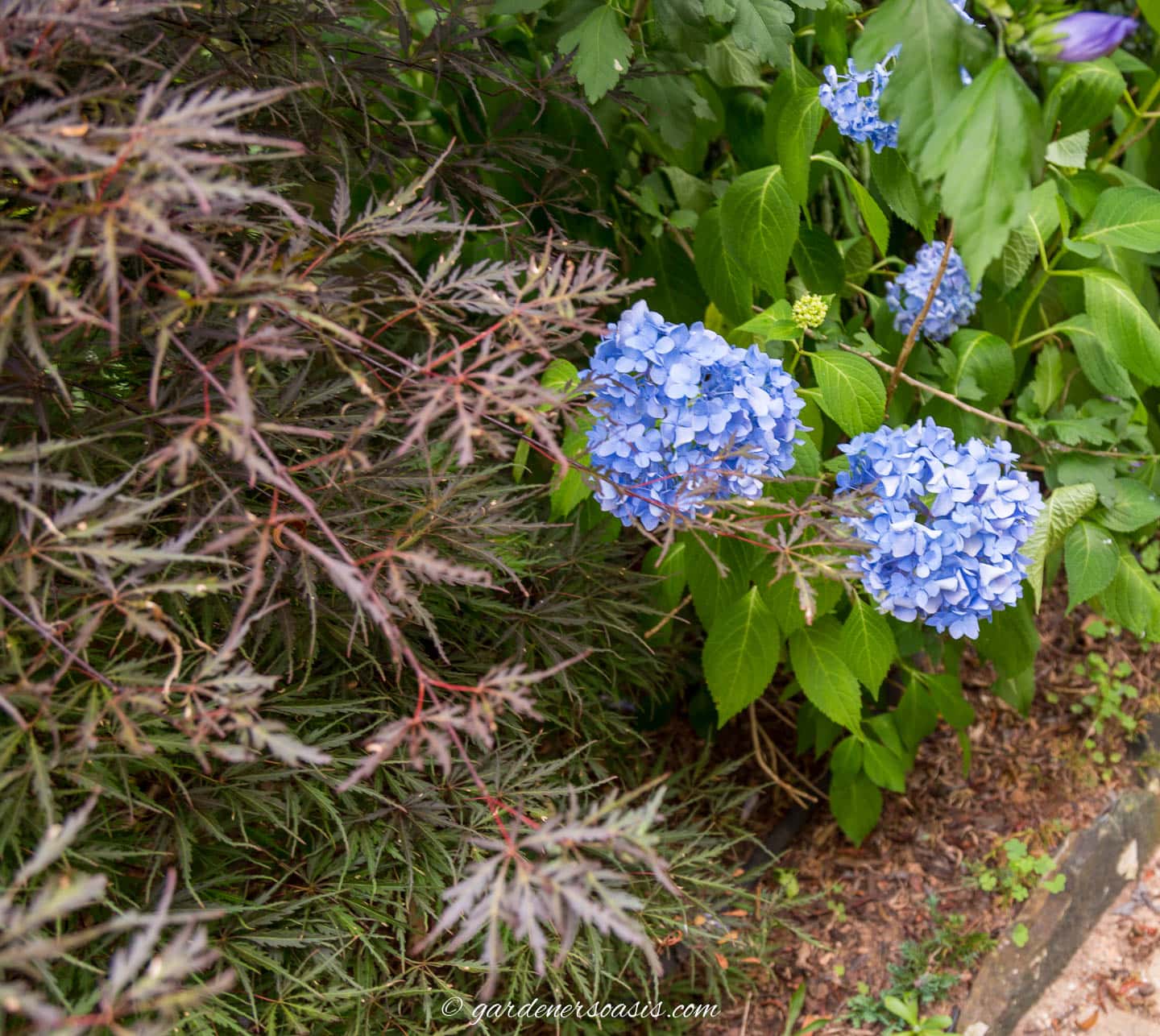
Scientific name: Acer palmatum
Zones: 5 to 9
Exposure: Part Shade
Height: 6′ to 25′ (depending on the variety)
Width: 6′ to 25′
Bloom Time: Foliage Only
Japanese maples are known for their elegant, spreading form, and fine, delicate foliage that is often red or purple in color.
This provides a beautiful contrast to the round, bushy form and large leaves of hydrangeas.
Larger Japanese Maple varieties provide a canopy of shade for Hydrangeas, while smaller ones can be planted either beside or in front of them.
These small trees are also known for their stunning fall color, which can extend the season of interest in your garden after the hydrangeas have finished blooming.
16 | Gardenia
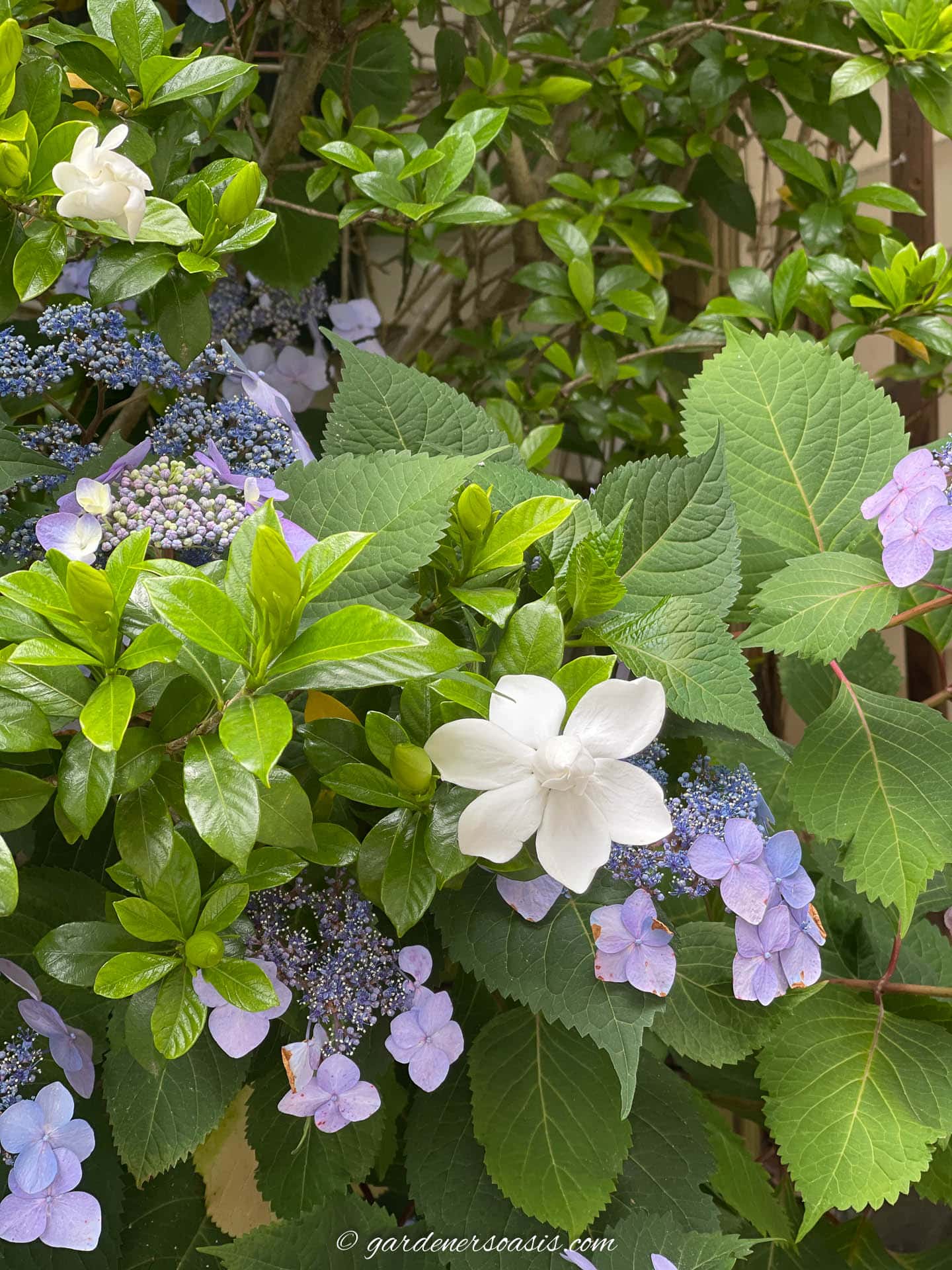
Scientific name: Gardenia jasminoides
Zones: 6 to 11
Exposure: Shade to Part Shade
Height: 2′ to 8′ (depending on the variety)
Spread: 4′ to 5′
Bloom time: Late spring to summer, often re-blooms in the fall
Bloom color: White
Gardenias are evergreen shrubs that are known for their intoxicating fragrance.
So planting them with hydrangeas, which lose their leaves in winter and typically have little to no scent, adds a sensory element to your garden.
The dark green glossy leaves and white flowers of gardenias also provide a striking contrast to the color and shape of hydrangea blooms.
This shrub likes to grow in acid soil. So if you plant them with a Hydrangea variety that can be either pink or blue, it will be blue.
If you live in a colder zone where Gardenias aren’t hardy, you can use Rhododendrons or Azaleas in its place.
17 | Rose of Sharon
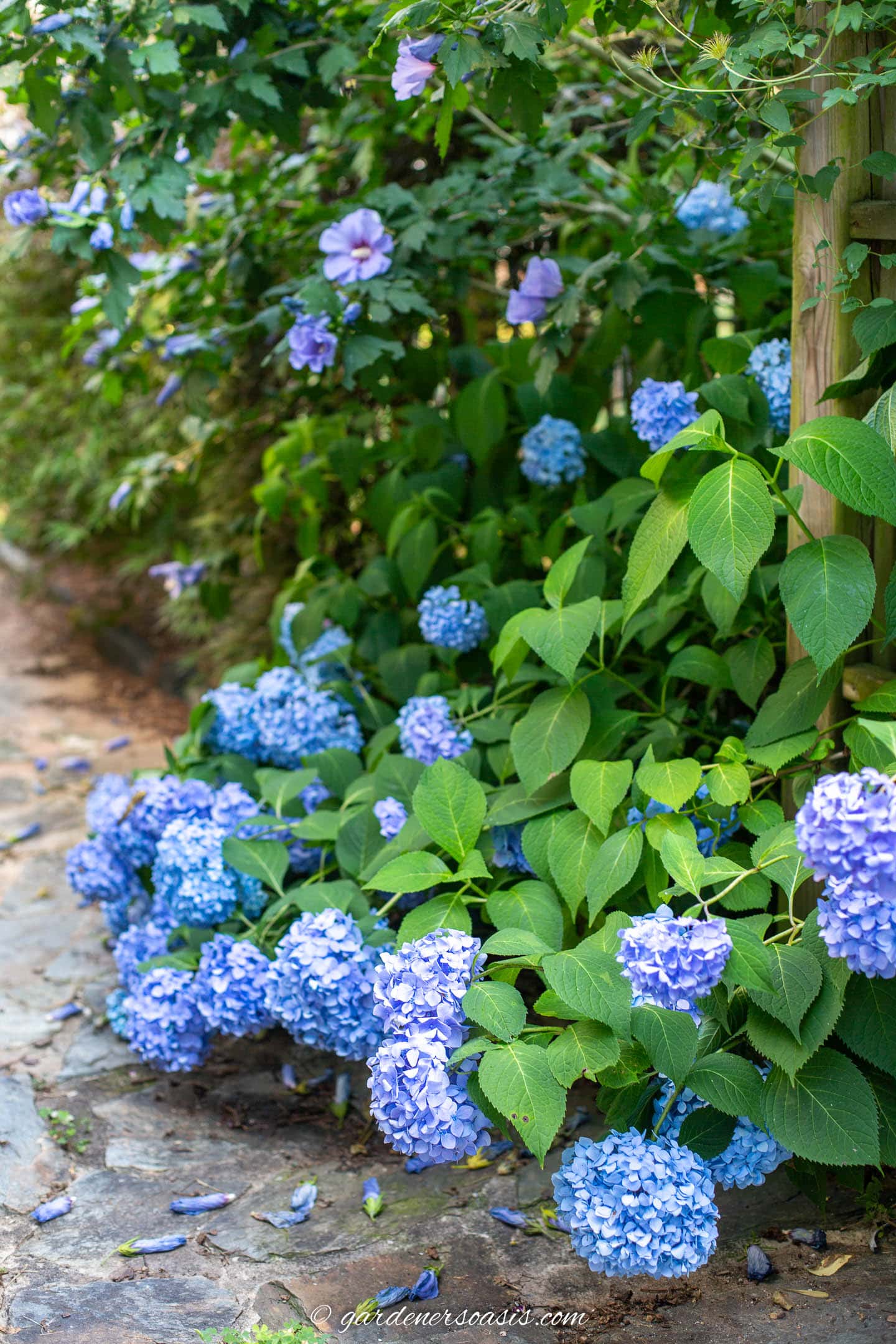
Scientific name: Hibiscus syriacus
Zone: 5 to 9
Exposure: Full sun
Height: 10′ to 16′
Width: 2′ to 3′
Bloom time: summer through fall
Bloom color: white, purple, blue, pink, red
Rose of Sharon is a tall shrub or small tree that typically blooms from late summer to fall.
It comes in a variety of colors, including white, pink, red, violet, and blue, which can either complement or contrast with the hydrangea blooms.
It also tends to have a columnar shape which provides a nice vertical contrast to the more rounded form of hydrangeas.
Some Rose of Sharon varieties can be quite vigorous and may self-seed prolifically, potentially leading to unwanted spread.
To prevent this, I usually trim the blooms off just as the they are fading.
18 | Crepe Myrtle
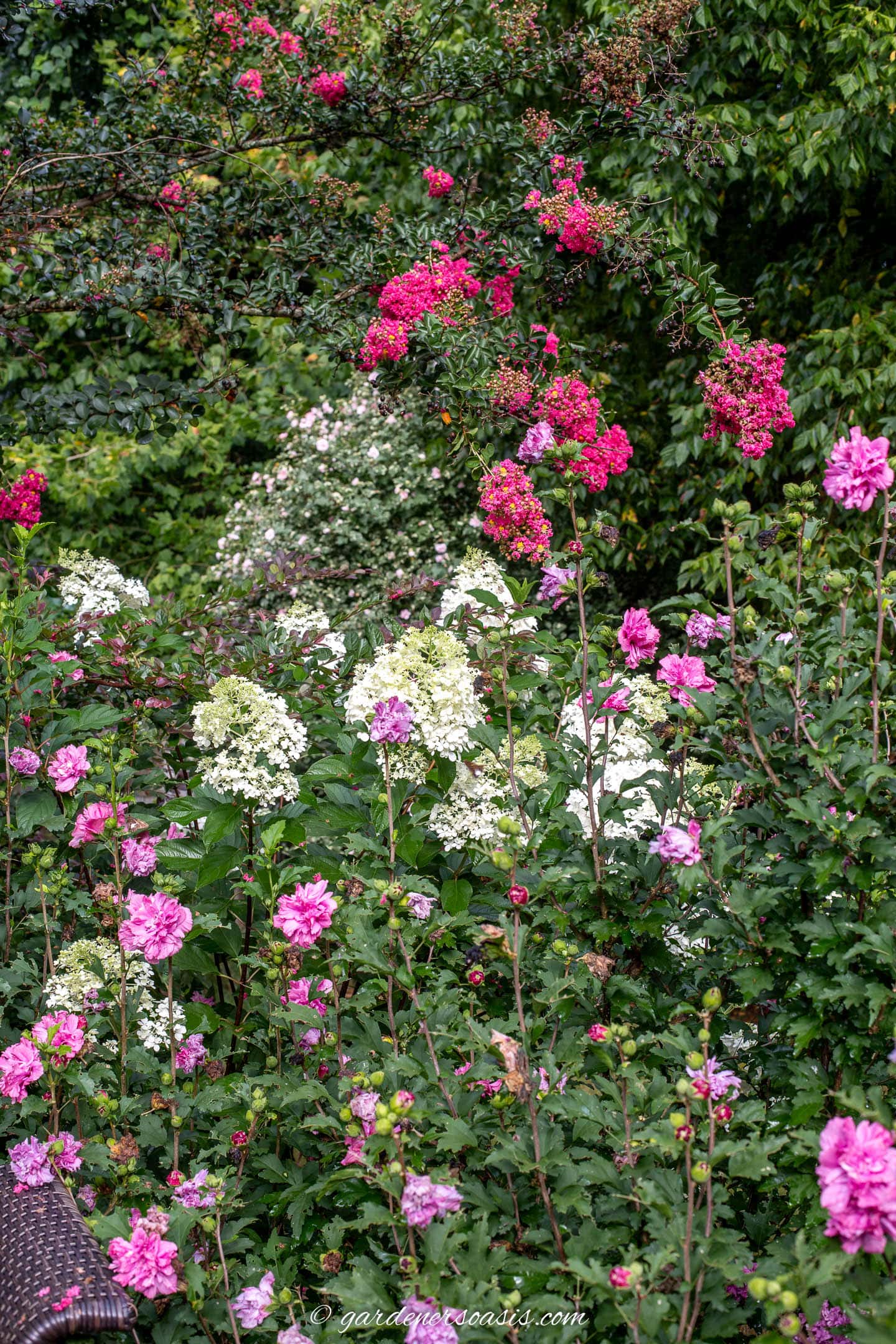
Scientific name: Lagerstroemia
Zone: 6 to 10
Exposure: Sun
Height: 25′
Width: 15′
Bloom time: Summer through fall
Bloom color: white, pink, red
Crepe myrtles are a large bush or small tree that grow taller than Hydrangeas.
So they make a great back of the border plant to highlight the beautiful hydrangea blooms
Their flowers come in a range of colors, including pink, purple, red, and white and usually appear in mid to late summer.
This coincides with the bloom time of many Hydrangea varieties, creating beautiful color combinations.
In addition, Crepe myrtles are known for their distinctive, exfoliating bark, which provides interest in the winter months when hydrangeas have lost their leaves and flowers.
19 | Traditional evergreens
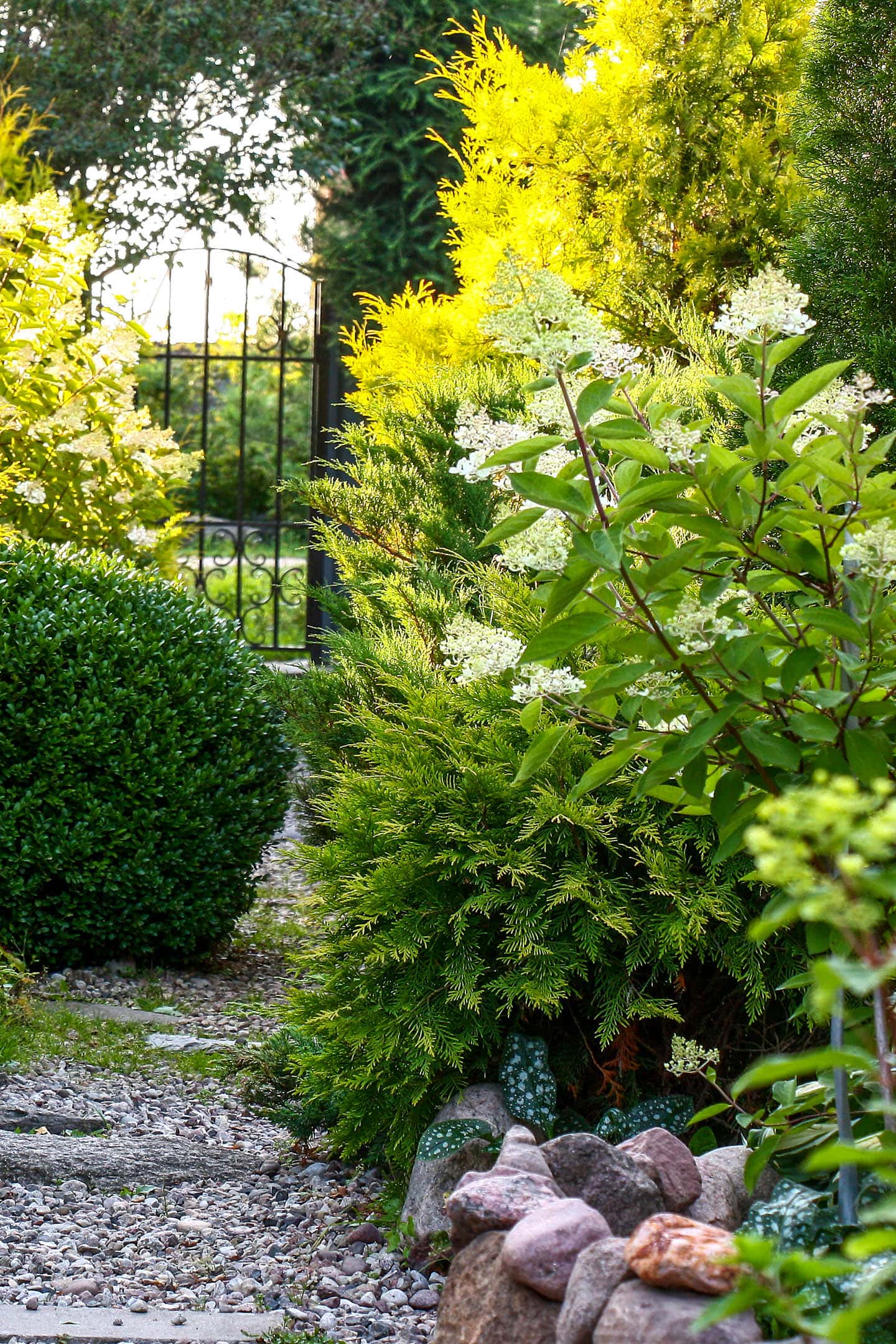
Scientific name: Various
Zone: 3 to 11
Exposure: Sun to part shade (depending on the variety)
Height: 1′ to 25′ (depending on the variety)
Width: 3′ to 12′ (depending on the variety)
Bloom time: Foliage only
Traditional evergreens, such as dwarf blue spruce and junipers, are low maintenance shrubs that grow in many different shapes, from compact, rounded ones to more conical forms.
These shapes as well as the fine, spiky texture of their needles contrast well with the loose structure and larger, softer leaves and flowers of Hydrangeas.
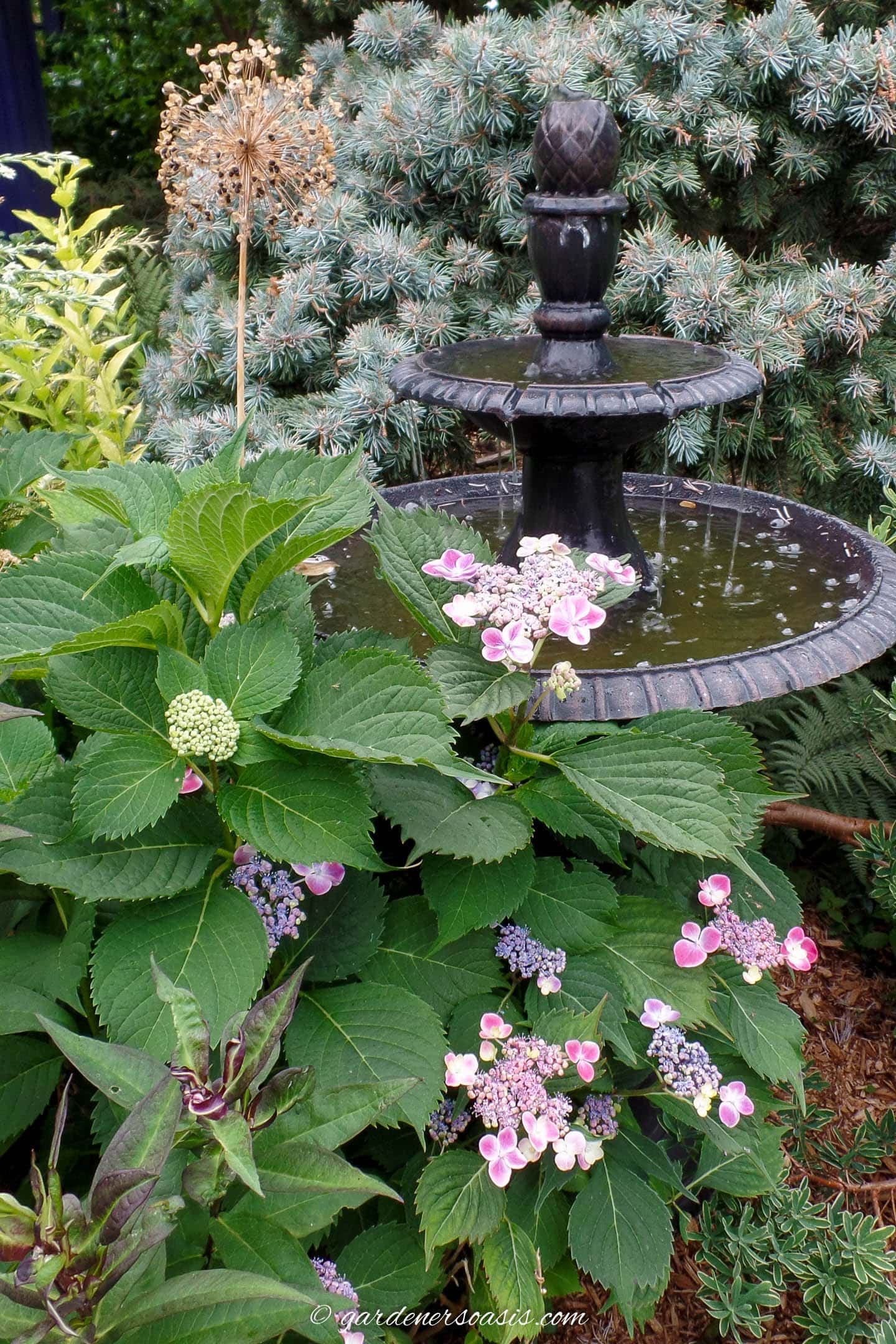
This adds layers of interest to your garden that extends into winter, since they retain their needles all year round.
20 | Annuals
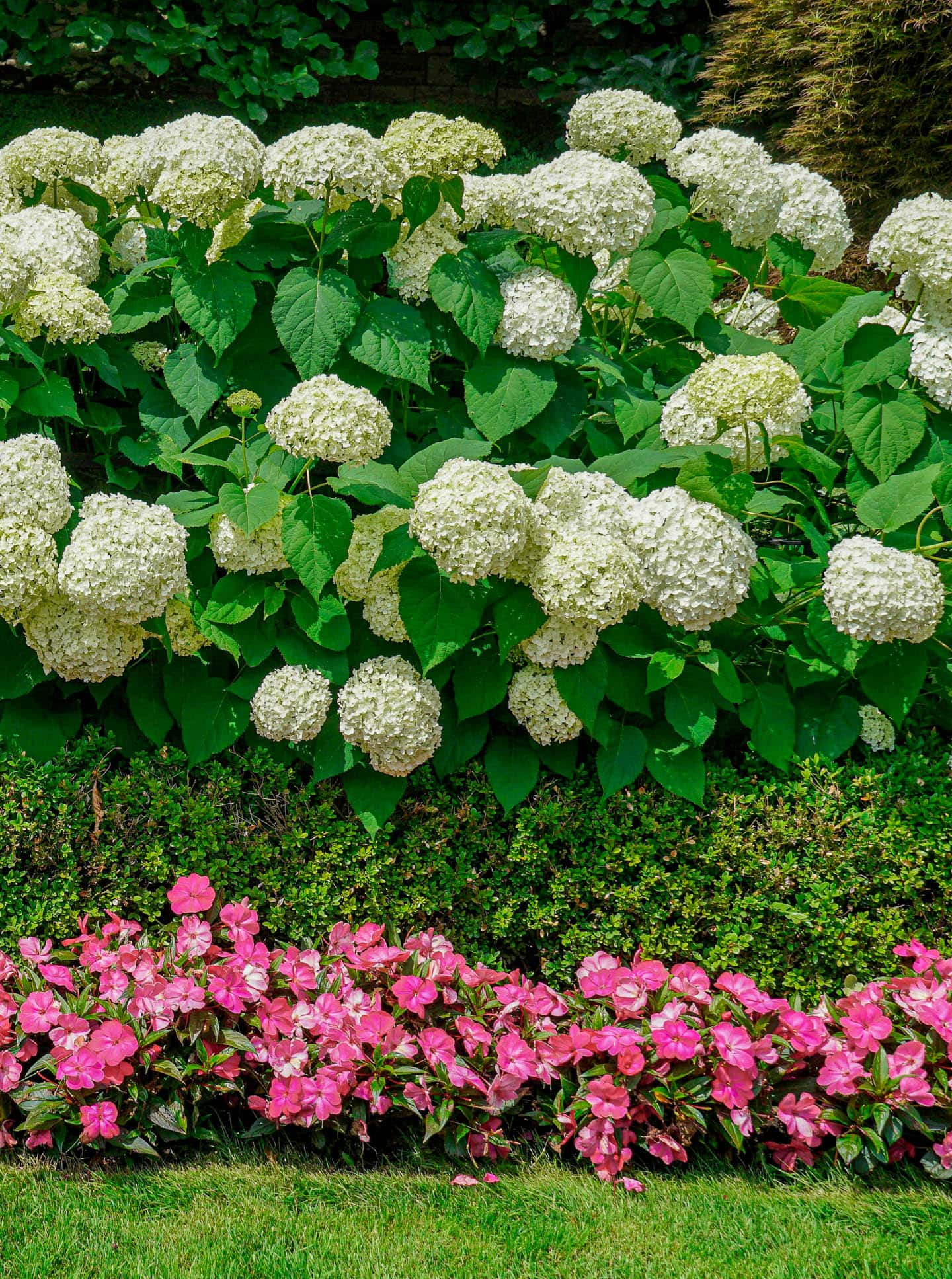
Another option for Hydrangea companion plants is annuals, such as Impatiens, Trailing Geraniums and Begonias.
They are known for their long bloom time, from spring until the first frost in fall which provides continuous color in your garden.
Because annuals come in so many colors, you can create a color scheme that either complements or contrasts with your hydrangeas, depending on what you like.
I like to use them to fill in gaps under and around larger plants like hydrangeas, to give the garden a fuller, more lush look.
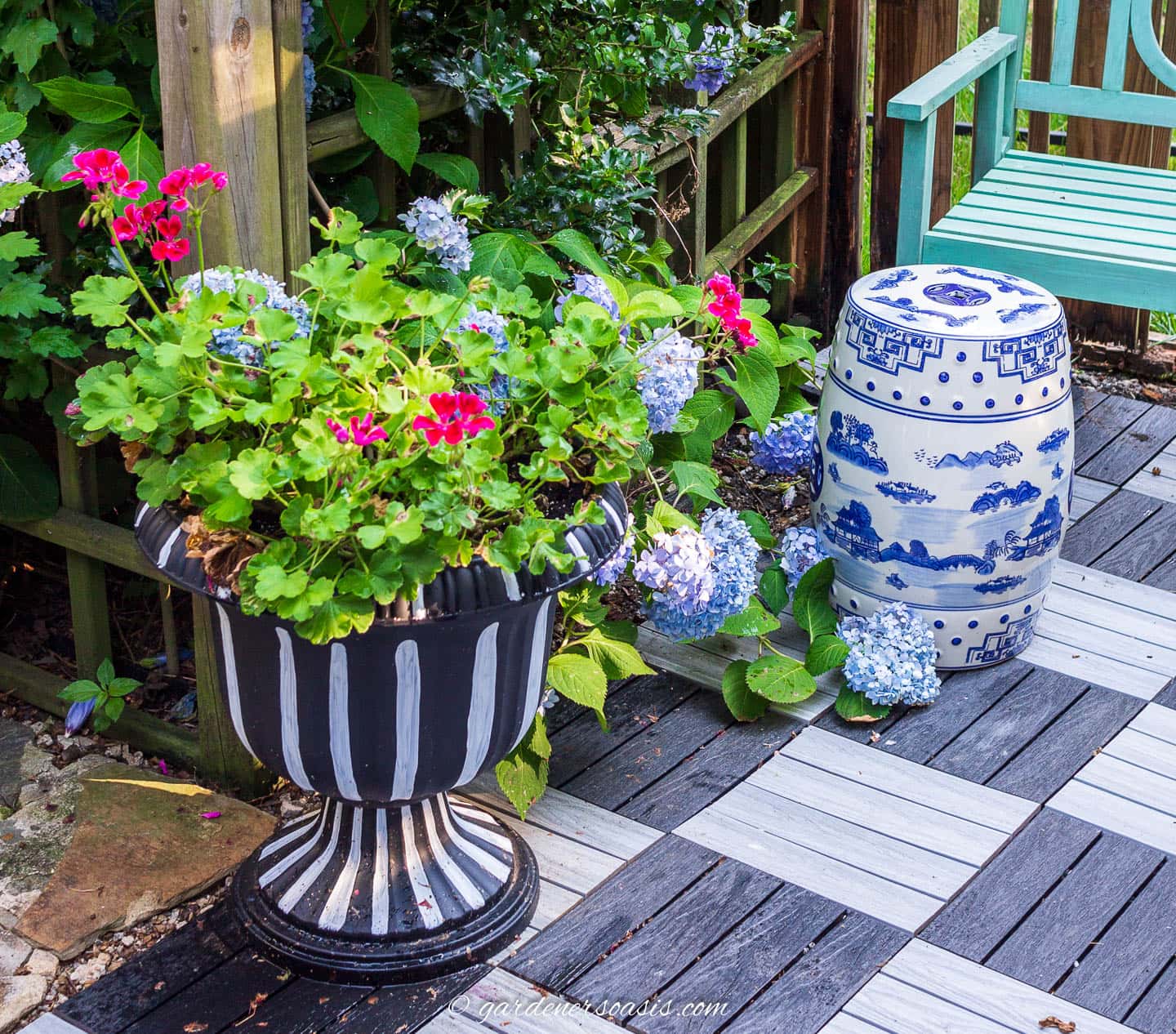
You can also plant the annuals in containers and place them near your Hydrangeas. Which provides flexibility as well as adding interest to your garden.
21 | Other Hydrangeas
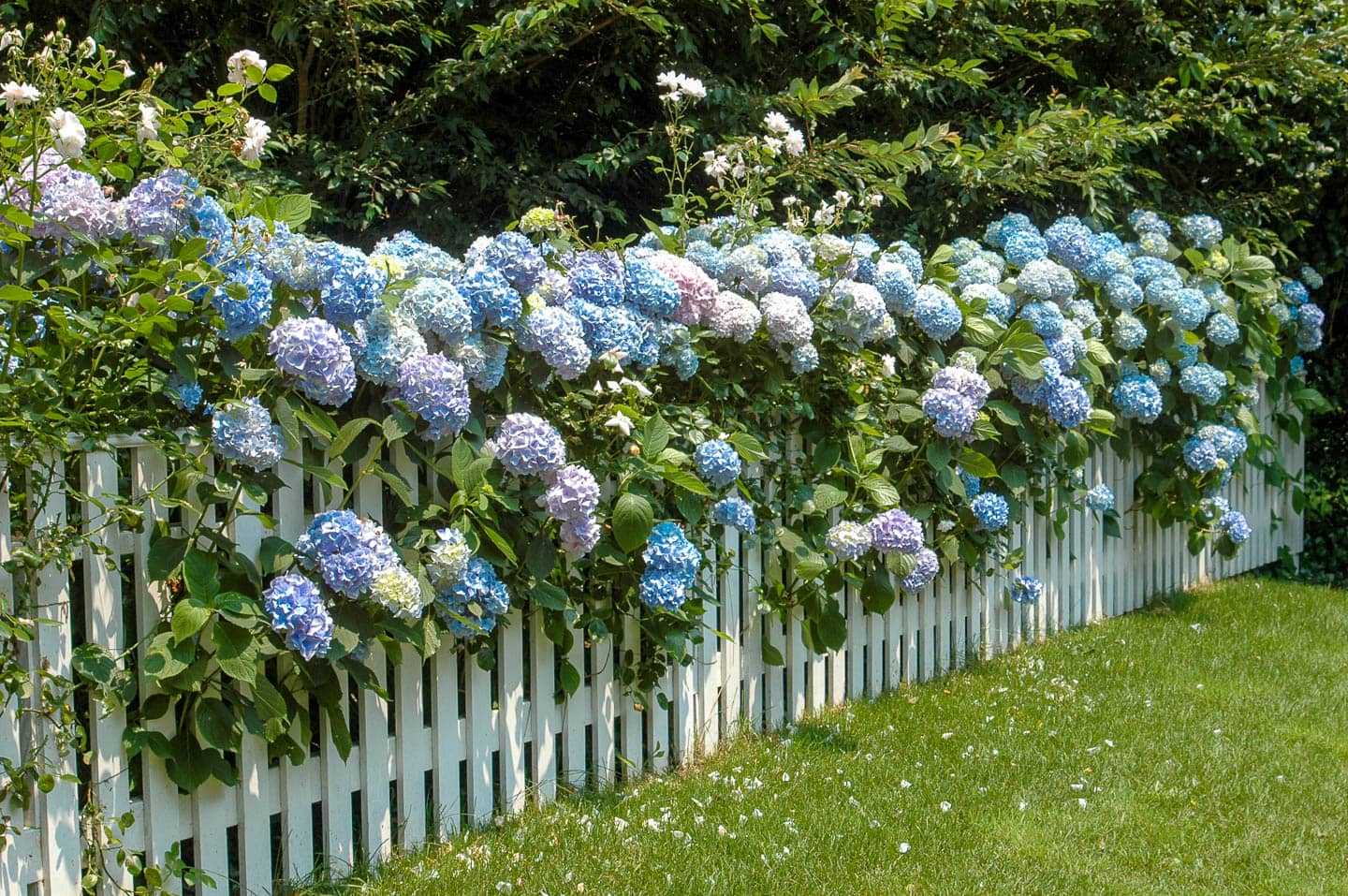
If you don’t want to come up with a bunch of different combinations, planting a mass of hydrangeas together is an easy way to create a dramatic visual impact.
Using all the same plant species creates a sense of unity and harmony in your garden design.
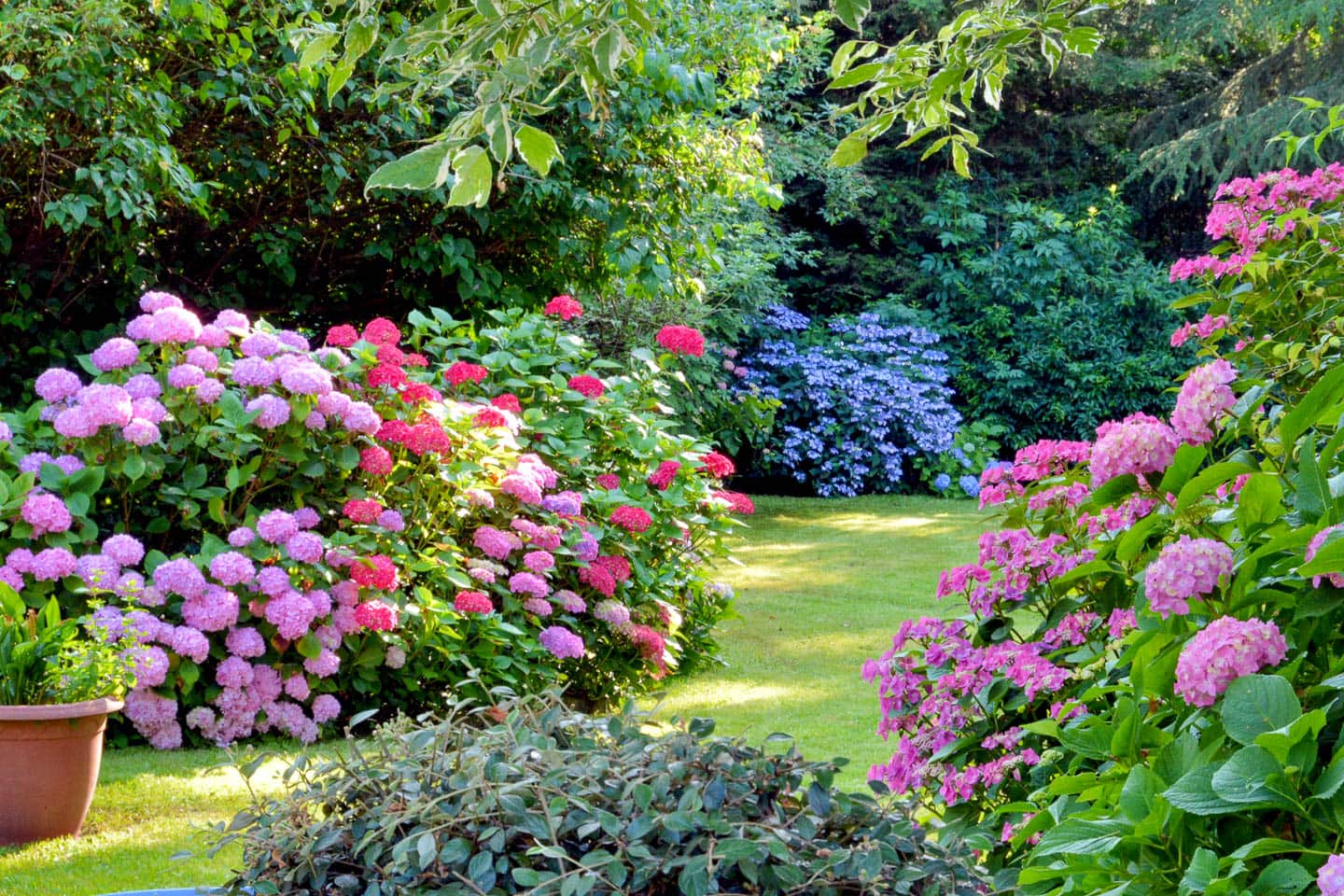
But there are so many different Hydrangea varieties that you can also mix and match different ones to create an interesting and diverse display.
Some Hydrangeas bloom early in the summer, others bloom later, and some even have repeat blooms.
By planting a combination of these, you can extend the blooming season and create continuous color in your garden throughout the season
Frequently asked questions
If you just want a list of Hydrangea companion plants to use in different situations, this is where you’ll find them.
What flowers go well with Hydrangeas?
- For Hydrangeas growing in shade, plant them with Hostas, Heuchera, Astilbe, Clematis, Azaleas, Bleeding Heart, Rhododendrons, Gardenia and annuals such as Impatiens and Begonias.
- For Hydrangeas in the sun, plant them with Roses, Daisies, Daylilies, Echinacea, Black-eyed Susan, Delphiniums, Russian Sage, Sedum ‘Autumn Joy’, Clematis, Rose of Sharon, Crepe Myrtle and annuals such as Geraniums.
What to plant behind Hydrangeas?
- Small trees or tall shrubs such as Rose of Sharon (Hibiscus syriacus), Crepe Myrtle (Lagerstroemia), or Japanese Maples (Acer palmatum) can create a backdrop that helps your hydrangeas stand out.
- Evergreen shrubs or trees like boxwoods (Buxus), hollies (Ilex), or dwarf blue spruce (Picea pungens ‘Glauca Globosa’) provide a contrasting color and texture while adding year-round interest.
- If you have a trellis or wall behind your hydrangeas, climbing plants like Clematis, or climbing roses add a vertical element to your garden.
What to plant in front of Hydrangeas?
- Low-growing perennials like Hostas, Coral Bells (Heuchera), Astilbe, Sedge, or low-growing ferns add contrasting textures and colors in front of Hydrangeas.
- Annuals such as Impatiens or Begonias also make good border Hydrangea companion plants by providing a continuous pop of color throughout the growing season.
- Plant spring-flowering bulbs like daffodils, tulips or crocuses to provide early color before the Hydrangeas start blooming.
Companion perennials for Hydrangeas
- For shade Hydrangeas, plant companion shade perennials such as Hostas, Astilbe, Ferns, Heuchera, Lungwort, Bleeding Heart, Sedge, Japanese Forest Grass and Japanese Anemone.
- For Hydrangeas in the sun, plant sun perennials such as Daylilies, Echinacea, Black-eyed Susan, Russian Sage, Delphiniums, and Sedum ‘Autumn Joy’
Companion shrubs for Hydrangeas
- Companion shrubs for shade Hydrangeas include Boxwood, Rhododendrons, Azaleas, Gardenias, Japanese Maples and Camellias.
- For sun Hydrangeas, plant Boxwood, Spirea, Viburnum, Rose of Sharon, Dwarf Blue Spruce, Roses and Crepe Myrtles.
Other Hydrangea information you might like
Have comments or questions on our Hydrangea companion plants? Tell us in the section below.
This post was originally published on May 26, 2023 but was updated with new content on February 16, 2024.
